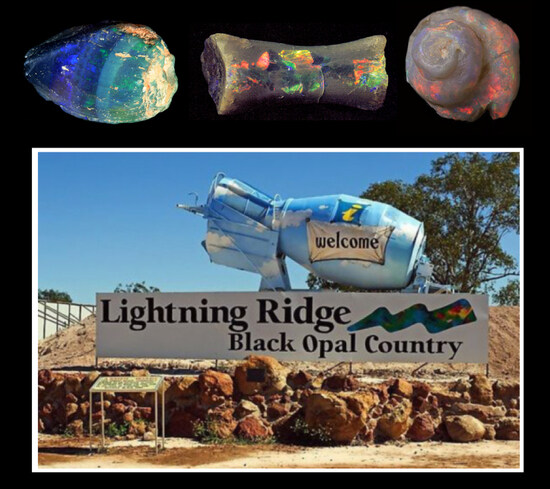Timing of Opalization at Lightning Ridge, Australia: New Evidence from Opalized Fossils
Abstract
:1. Introduction
2. Geological Setting
3. Site History
4. Opal Nomenclature
5. Opal Formation Hypotheses
5.1. Deep Weathering
5.2. Syntectonic Opalization
5.3. Cretaceous Microbial Origin
5.4. Modern Microbial Origin
5.5. Artesian Water/Mound Springs Model
5.6. Gamma Radioactivity and Nano-Nuclides
5.7. Rapid Opal Synthesis
6. Opal Topologies
6.1. Seam Opal
6.2. Nobbies (Nodules)
6.3. Septarian Networks, Reticulations, Melikaria, and Meniscus Structures
6.4. “Ball-and-Pillow Structures” or “Foam Balls”
6.5. Opalized Fossils
7. Materials and Methods
8. Paleontology
9. Results
9.1. Evidence from Plant Fossils
9.2. Evidence from Invertebrate Fossils
9.3. Evidence from Vertebrate Fossils
9.4. Evidence from Ichnofossils
10. Non-Opal Silicification
11. Evidence from Other Opal Localities
11.1. European Opal Deposits
11.2. Evidence from Silicified Wood
11.3. Cenozoic Opal from Nevada, USA
12. Opal Diagenesis
12.1. Biogenic Silica
12.2. Silica Sinter
13. Discussion
14. Conclusions
Author Contributions
Funding
Data Availability Statement
Acknowledgments
Conflicts of Interest
References
- Chauviré, B.; Robdeau, B.; Mazzero, F.; Ayalew, D. The precious opal deposit at Wegel Tena, Ethiopia: Formation vial successive pedogenic events. Can. Mineral. 2017, 55, 707–723. [Google Scholar] [CrossRef]
- Rondeau, B.; Cenki-tx, B.; Fritsch, E.; Maxxero, F.; Beckele, E.; Gallou, E.; Ayalew, D.; Beckele, E.; Gaillou, E.; Ayalew, D. Geochemical and petrological characterization of gem opals from Wegel Tena, Welo, Ethiopia: Opal formation in soil. Geochem. Explan. Environ. Anal. 2012, 49, 827–836. [Google Scholar]
- Berger, B. Fossilized Insect Discovered Not in Amber, But in Opal. EntomologyToday, 18 January 2019. Available online: https://entomologytoday.org/2019/01/18/fossilized-insect-discovered-amberopal/?fbclid=IwAR3tvq4p9ZxpCQ8qBNd29sRDsvWxLu_DpKqC9SgOwPgPvxuwFGVH8g3yBcQ# (accessed on 12 September 2023).
- Coldham, T.; Ivey, J. A visit to the Indonesian opal fields in 2019—Opal types, mining and treatments, Part 1. Aust. Gemmol. 2020, 27, 199–213. [Google Scholar]
- Henderson, R.A.; Johnson, D. The Geology of Australia, 3rd ed.; Cambridge University Press: Cambridge, UK, 2016; p. 375. [Google Scholar]
- Brown, D.A.; Capbell, K.S.W.; Crook, K.A.W. Geological Evolution of Australia and New Zealand; Pergamon Press: Oxford, UK, 1968; p. 409. [Google Scholar]
- Bryan, S.E.; Constantine, A.E.; Stephens, C.J.; Ewart, A.; Schön, R.E.; Parianos, J. Early Cretaceous volcano-sedimentary successions along the eastern Australia continental margin: Implications for the break-up of eastern Gondwana. Earth Planet. Sci. Lett. 1997, 153, 85–102. [Google Scholar] [CrossRef]
- Rey, P.F. Opalization of the Great Artesian Basin (central Australia): And Australia story with a Martian twist. Aust. J. Earth Sci. 2013, 6, 291–314. [Google Scholar] [CrossRef]
- Bell, P.R.; Brougham, T.; Herne, M.C.; Frauenfelder, T.; Smith, E.T. Fostoria dhimbangunmal, gen. et sp. nov., a new iguanodontian (Dinosauria, Ornithopoda) from the mid-Cretaceous of Lightning Ridge, New South Wales, Australia. J. Vertebr. Paleontol. 2019, 39, e1564757. [Google Scholar] [CrossRef]
- Bell, P.R.; Fanti, F.; Hart, L.J.; Milan, L.A.; Craven, S.J.; Brougham, T.; Smith, E. Revised geology, age and vertebrate diversity of the dinosaur-bearing Griman Creek Formation (Cenomanian), Lightning Ridge, New South Wales, Australia. Palaeogeogr. Palaeoecol. Palaeoclimatol. 2019, 514, 31–182. [Google Scholar] [CrossRef]
- Dutkiewicz, A.; Landgrebe, T.C.W.; Rey, P.F. Origin of silica and fingerprinting of Australian and sedimentary opals. Gondwana Res. 2015, 27, 785–795. [Google Scholar] [CrossRef]
- Herrmann, J.; Maas, R. Formation of sediment-hosted Opal-AG at Lightning Ridge (New South Wales, Australia): Refining the deep-weathering model. J. Geol. 2022, 130, 77–109. [Google Scholar] [CrossRef]
- Smith, E.; Smith, R. Black Opal Fossils of Lightning Ridge; Kangaroo Press: East Roseville, NSW, Australia, 1999; p. 112. [Google Scholar]
- Smallwood, A.G. A new era for opal nomenclature. Aust. Gemmol. 1997, 19, 486–496. [Google Scholar]
- Levin, I.; Ott, E. X-ray study of opals, silica glass and silica gel. Z. Kristallogr. 1933, 85, 305–318. [Google Scholar] [CrossRef]
- Dwyer, F.O.; Mellor, D.P. An X-ray study of opals. J. Proc. R. Soc. NSW 1934, 68, 47–50. [Google Scholar] [CrossRef]
- Jones, J.B.; Segnit, E.R. The nature of opal I. Nomenclature and constituent Phases. J. Geol. Soc. Aust. 1971, 18, 57–68. [Google Scholar] [CrossRef]
- Jones, J.B.; Segnit, E.R. Nomenclature and structure of natural disordered (opaline) silica. A comment on the paper “A new interpretation of the structure of disordered α-cristobalite” by M.J. Wilson, J.D. Russell and J.M. Tait. Contrib. Mineral. Petrol. 1975, 51, 231–234. [Google Scholar] [CrossRef]
- Smith, D.K. Opal, cristobalite, and tridymite: Noncrystallinity versus crystallinity, nomenclature of the silica minerals and bibliography. Powder Diffr. 1998, 13, 2–19. [Google Scholar] [CrossRef]
- Curtis, N.J.; Gascooke, J.R.; Johnston, M.R.; Pring, A. A review of the classification of opal with reference to recent new localities. Minerals 2019, 9, 299. [Google Scholar] [CrossRef]
- Iler, R.K. The Chemistry of Silica; John Wiley & Sons: New York, NY, USA, 1978; p. 896. ISBN 978-0-471-02404-0. [Google Scholar]
- Pecover, S.R. A new genetic model for the origin of opal in the Great Australian Basin. Mesozoic Geology of the Eastern Australia Plate Conference, Geological Society of Australia. Ext. Abstr. 1996, 43, 450–454. [Google Scholar]
- Pecover, S.R. The new syntectonic model of origin to explain the formation of opal veins (“seams” and “nobbies”), breccia pipes (“blows”) and faults (“slides”) at Lightning Ridge. In Proceedings of the 1st National Opal Symposium, Lightning Ridge, Australia; 1999; pp. 1–31. [Google Scholar]
- Pecover, S.R. Structures related to opal deposits at Lightning Ridge. Symposium: Exploring for opal. In The Earth Resources Foundation and the Lightning Ridge Miners Association; The University of Sydney: Camperdown, Australia, 2003; pp. 1–5. [Google Scholar]
- Pecover, S. Breccia Pipes: Fluid Pathways of the Opal Gods. 4th National Opal Symposium, Lighting Ridge. 2005. Available online: https://www.researchgate.net/publication/319255338_BRECCIA_PIPES_-_FLUID_PATHWAYS_OF_THE_OPAL_GODS (accessed on 25 August 2023).
- Pecover, S. Australian opal resources: Outback spectral fire. Rocks Miner. 2007, 82, 103–115. [Google Scholar] [CrossRef]
- Pecover, S. Recent Advances to the Syntectonic Model and Its Applicability to Opal Exploration Along the CollarenebriAntiform; Pan Gem Resources (Aust) Ltd. 2011, pp. 1–23. Available online: https://vdocuments.net/recent-advances-to-the-syntectonic-model-and-its-applicability-to-opal-exploration-along-the-collarenebri-antiform-full-paper-figures.html?page=1 (accessed on 25 August 2023).
- Pecover, S. Key Features of Opal Vein Deposits at Lightning Ridge, NSW, Australia, 34 International Geological Conference, Australia 2012, Sydney, Australia. Available online: https://www.researchgate.net/publication/319255402_KEY_FEATURES_OF_OPAL_VEIN_DEPOSITS_AT_LIGHTNING_RIDGE_NSW_AUSTRALIA_Pan_Gem_Resources_Aust_Pty_Ltd_Photo_by_Sarah_Pecover/link/599e373d0f7e9b892bb40f13/download (accessed on 7 July 2023).
- Pecover, S. Australian Opal- How Did It Form? Teacher Earth Science Education Program Case Study 1.006. 2015. Available online: https://www.researchgate.net/publication/319235421_Australian_Opal-How_did_it_form (accessed on 25 August 2023).
- Behr, H.J.; Behr, K.; Watkins, J.J. Cretaceous microbes—Producer of black opal at Lightning Ridge, NSW, Australia. In Proceedings of the 15th Australian Geological Convention, Society of Australia Abstracts, Sydney, Australia, 3–7 July 2000; Volume 59, p. 28. [Google Scholar]
- Watkins, J.J.; Behr, H.J.; Behr, K. Fossil microbes in opal from Lightning Ridge—Implications for the formation of opal. Q. Notes Geol. Surv. New South Wales 2011, 136, 1–21. [Google Scholar]
- Gallacher, A.D. Geochemistry of Sedimentary Opal, Hebel, Southern Queensland, Chapter 6. Biomineralization, the Possible Role of Microbes in the Redistribution of Silica; Weathering and Genesis of Opal. Ph.D. Thesis, School of Earth Sciences, The University of Melbourne, Melbourne, Australia, 2001; pp. 138–146. [Google Scholar]
- Herrmann, J.R.; Maas, R.; Rey, P.F.; Best, S.P. The nature and origin of pigments in black opal from Lightning Ridge, New South Wales, Australia. Aust. J. Earth Sci. 2019, 66, 1027–1039. [Google Scholar] [CrossRef]
- Dowell, K.; Mavrogenes, J.; McPhail, D.C.; Watkins, J. Origin and timing of formation of precious black opal nobbies at Lightning Ridge. In Regolith and Landscape of Eastern Australia; Roach, I.C., Ed.; CRC LEME: Sydney, Australia, 2002; pp. 18–20. [Google Scholar]
- Deveson, B. Microbes Associated with Precious Opal and the Implications for the Age of the Opal: Research Note. 2022. Available online: https://www.researchgate.net/publication/358794316_Microbes_associated_with_precious_opal_and_the_implications_for_the_age_of_the_opal_Research_note (accessed on 25 August 2023).
- Deveson, B. The Role of Artesian Water in the Formation of Precious Opal. Presented at 2007, Opal Symposium Coober Pedy. Available online: https://www.researchgate.net/publication/338828655_The_role_of_artesian_water_in_the_formation_of_precious_opal_in_the_Lightning_Ridge_district (accessed on 25 August 2023).
- Deveson, B. A New Model of the Formation of Precious Opal: Updated Notes, April 2022. Available online: https://www.researchgate.net/publication/360235468_Opal_New_Model_updated_notes (accessed on 25 August 2023).
- Deveson, B. The origin of precious opal. Aust. Gemmol. 2004, 22, 50–58. [Google Scholar]
- Dickson, B.L. Which water formed Australian sediment-hosted precious and potch opal? Aust. J. Earth Sci. 2019, 66, 644–655. [Google Scholar] [CrossRef]
- Senior, B.R.; Chadderton, L.T. Natural gamma radioactivity and exploration for precious opal in Australia. Aust. Gemmol. 2007, 23, 160–176. [Google Scholar]
- Smallwood, A. 35 years on. A new look at synthetic opal. Aust. Gemmol. 2003, 21, 438–447. [Google Scholar]
- Hodges, M.A. Len Cram An Opal Icon. Available online: https://www.sunriseopals.com/pages/len-cram-an-opal-icon (accessed on 12 July 2023).
- McManus, G. The man who grows opals. Australas. Post 1988, 6, 18–20. [Google Scholar]
- Shepherd, R. The Birth of Opal—Natural and Synthetic; CreateSpace Independent Publishing: Scotts Valley, CA, USA, 2013; p. 460. [Google Scholar]
- Solingen, A.A. Growing opals—Australian style. Creation 1989, 12, 10–15. [Google Scholar]
- Stelling, A.A. Rapid opals in the Outback. Answ. Mag. 2015, 20, 46–48. [Google Scholar]
- Hounslow, M.H. Significance of localized pore pressures to the genesis of septarian concretions. Sedimentology 1997, 44, 1133–1147. [Google Scholar] [CrossRef]
- Pratt, B.R. Septarian concretions: Internal cracking caused by synsedimentary earthquakes. Sedimentology 2001, 48, 189–213. [Google Scholar] [CrossRef]
- Burt, F.A. Melikaria: Vein complexes resembling septaria veins in form. J. Geol. 1928, 6, 544–549. [Google Scholar] [CrossRef]
- Woodward, A.S. On remains of a megalosaurian dinosaur from New South Wales. Rep. Br. Assoc. Adv. Sci. 1910, 79, 482–483. [Google Scholar]
- von Huene, F. Die fossileReptil-OrdnungSaurischia, ihteEntwicklung und Geschichte. Monogr. Geol. Und. Palaeontol. 1932, 1, 361. [Google Scholar]
- Bell, P.R.; Herne, M.C.; Brougham, T.; Smith, E.T. Ornithopod diversity in the Griman Creek Formation (Cenomanian), New South Wales, Australia. PeerJ 2018, 6, e6008. [Google Scholar] [CrossRef] [PubMed]
- Bell, P.R.; Cau, A.; Fanti, F.; Smith, E. A large-clawed theropod (Dinosauria: Tetanurae) from the Lower Cretaceous of Australia and the Gondwanan origin of megaraptorid theropods. Gondwana Res. 2016, 36, 473–487. [Google Scholar] [CrossRef]
- Brougham, T.; Smith, E.T.; Bell, P.R. Noasaurids are a component of the Australian ‘mid’-Cretaceous theropod fauna. Sci. Rep. 2020, 10, 1428. [Google Scholar] [CrossRef] [PubMed]
- Frauenfelder, T.; Bell, P.R.; Campione, N.E.; Smith, E.T. Diversity and paleoecology of Australia’s southern-most sauropods, Griman Creek Formation (Cenomanian) New South Wales. Lethaia 2021, 54, 354–367. [Google Scholar] [CrossRef]
- Archer, M.; Flannery, T.F.; Ritchie, A.; Molnar, R.E. First Mesozoic mammal from Australia—An early Cretaceous monotreme. Nature 1985, 318, 363–366. [Google Scholar] [CrossRef]
- Flannery, T.F.; Archer, M.; Rich, T.H.; Jones, R. A new family of monotremes from the Cretaceous of Australia. Nature 1995, 377, 418–420. [Google Scholar] [CrossRef]
- Mustoe, G.E. Non-mineralized fossil wood. Geosciences 2018, 8, 223. [Google Scholar] [CrossRef]
- Lucjaz, J.A.; Leavitt, S.W.; Csank, A.Z.; Panyushkina, I.P. Comment on “non mineralized fossil wood” by George E. Mustoe (Geosciences, 2018). Geosciences 2018, 8, 462. [Google Scholar]
- Mustoe, G.E. Wood petrifaction: A new view of permineralization and replacement. Geosciences 2017, 7, 119. [Google Scholar] [CrossRef]
- Berkshire Community College Bioscience Library. A Public Domain Open Educational Resource. Berkshire County, MA, USA. Available online: https://blogs.berkshirecc.edu/bccoer/plant-morphology-angiosperm-stems/ (accessed on 25 August 2023).
- Bell, P.R.; Bicknell, R.D.C.; Smith, E.T. Crayfish bio-gastroliths from eastern Australia and the middle Cretaceous distribution of Parastacidae. Geol. Mag. 2020, 57, 1023–1030. [Google Scholar] [CrossRef]
- Utami, W.S.; Herdianita, N.R.; Atmaja, R.W. The Effect of Temperature and pH on the Formation of Silica Scaling of Dieng Geothermal Field, Central Java, Indonesia. In Proceedings of the Thirty-NinthWorkshop on Geothermal Reservoir Engineering, Stanford University, Stanford, CA, USA, 24–26 February 2014. [Google Scholar]
- Nicholson, K. Geothermal Fluids: Chemistry and Exploration Techniques; Springer: Berlin/Heidelberg, Germany, 1968; 263p. [Google Scholar]
- Pewkliang, B.; Pring, A.; Brugger, J. Opalisation of fossil bone and wood: Clues to the formation of precious opal. In Regolith; Roach, I.C., Ed.; CR LME: Sydney, Australia, 2004; pp. 264–268. [Google Scholar]
- Pewkliang, B.; Pring, A.; Brugger, J. The formation of precious opal: Clues from the opalisation of bone. Can. Mineral. 2008, 46, 139–149. [Google Scholar] [CrossRef]
- Wedel, M.J. The evolution of vertebral pneumaticity in sauropod dinosaurs. J. Vert. Paleontol. 2003, 23, 344–357. [Google Scholar] [CrossRef]
- Aureliano, T.; Ghilardi, A.M.; Müller, R.T.; Kerber, L.; Pretto, F.; Fernandez, M.A.; Ricard-Btanco, F.; Wedel, M. The absence of an invasive air sac system in the earliest dinosaurs suggests multiple origins of vertebral pneumaticity. Sci. Rep. 2022, 12, 20844. [Google Scholar] [CrossRef] [PubMed]
- Gianchinia, F.A.; Zurriaguzm, V.L. Vertebral pneumaticity of the paravian theropod Unenlagiacomanhuensis, from the Upper Cretaceous of Patagonia, Argentina. Cretac. Res. 2021, 127, 104925. [Google Scholar] [CrossRef]
- Taylor, M.P.; Wedel, M.J. Why Is Vertebral Pneumaticity in Sauropod Dinosaurs so Variable? Quios 2021. Available online: https://www.qeios.com/read/1G6J3Q.5 (accessed on 15 September 2023).
- Brougham, T.; Smith, E.T.; Bell, P.R. New theropod (Tetanurae: Avetheropoda) material from the ‘mid’-Cretaceous Griman Creek Formation at Lightning Ridge, New South Wales, Australia. R. Soc. Open Sci. 2018, 6, 180826. [Google Scholar] [CrossRef] [PubMed]
- Hunt, A.P.; Lucas, S.G. Descriptive terminology of coprolites and recent feces. In Vertebrate Coprolites; Hunt, A.P., Milàn, J., Lucas, S.G., Spielmann, J.A., Eds.; New Mexico Museum of Natural History and Science, Bull: Albuquerque, NM, USA, 2012; pp. 152–160. [Google Scholar]
- Mustoe, G.E. Silicification of wood: An overview. Minerals 2023, 13, 206. [Google Scholar] [CrossRef]
- Palgutová, S.; Štrba, Ľ. Geoheritage of the precious opal bearing zone in Libanka Mining District (Slovakia) and its geotourism and geoeducation potential. Land 2022, 11, 2293. [Google Scholar] [CrossRef]
- Miró, J.; Martin-Martin, J.D.; Ibáñez, J.; Anadón, P.; Oms, O.; Tritila, J.; Caja, M.A. Opaline chert nodules in maar lake sediments from Camp del Ninots (La Selva basin, NE Spain. Geo-Temas 2016, 16, 387–390. [Google Scholar]
- Damour, A. Chemical composition of menilite. Z. Fuer Krist. Und. Mineral. 1888, 11, 640–641. [Google Scholar]
- Porfiryev, V. Carpathian menilite. Rocks Miner. 1970, 45, 145–146. [Google Scholar]
- Mustoe, G.E. Late Tertiary petrified wood from Nevada, USA: Evidence of multiple silicification processes. Geosciencess 2015, 5, 286–309. [Google Scholar] [CrossRef]
- Chauviré, B.; Mollé, V.; Guichard, F.; Rondeau, B.; Thomas, P.S. Cracking in gem opals. Minerals 2023, 13, 356. [Google Scholar] [CrossRef]
- Smallwood, A.G.; Thomas, P.; Ray, A.S. Comparative analysis of sedimentary and volcanic precious opals from Australia. J. Australas. Ceram. Soc. 2008, 44, 17–22. [Google Scholar]
- Liesegang, M.; Tomaschek, F. Tracing the continental diagenetic loop of the opal-A to opal-CT transition with X-ray diffraction. Sed. Geol. 2020, 398, 105603. [Google Scholar] [CrossRef]
- Murata, K.J.; Nakata, J.K. Cristobalitic Stage in the Diagenesis of Diatomaceous Shale. Science 1974, 184, 567–568. [Google Scholar] [CrossRef]
- Ijima, A.; Tada, R. Silica diagenesis of Neogene diatomaceous and volcaniclastic sediments in northern Japan. Sedimentology 1981, 28, 185–200. [Google Scholar] [CrossRef]
- Mizutani, S. Silica Minerals in the Early Stage of Diagenesis. Sedimentology 1970, 15, 419–436. [Google Scholar] [CrossRef]
- Mizutani, S. Progressive ordering of cristobalite in early stages of diagenesis. Contrib. Mineral. Petrol. 1977, 129–140. [Google Scholar] [CrossRef]
- Hein, J.R.; Scholl, D.W.; Barron, J.A.; Jones, M.G.; Miller, J. Diagenesis of late Cenozoic diatomaceous deposits and formation of the bottom simulating reflector in the southern Bering Sea. Sedimentology 1978, 25, 155–181. [Google Scholar] [CrossRef]
- Hein, J.R.; Yeh, H.W.; Barron, J.A. Eocene Diatom Chert from Adak Island, Alaska. J. Sediment. Res. 1990, 60, 250–257. [Google Scholar] [CrossRef]
- Mustoe, G.E. Diatomaceous origin of siliceous shale in Eocene lake beds of central British Columbia. Can. J. Earth Sci. 2005, 42, 231–241. [Google Scholar] [CrossRef]
- Cady, S.L.; Wenk, H.R.; Downing, K.H. HRTEM of microcrystalline opal in chert and porcellanite from the Monterey Formation, California. Am. Mineral. 1996, 81, 1380–1395. [Google Scholar] [CrossRef]
- Kastner, M.; Keene, J.; Gieskes, J. Diagenesis of siliceous oozes—I. Chemical controls on the rate of opal-A to opal-CT transformation—An experimental study. Geochim. Cosmochim. Acta 1977, 41, 1041–1059. [Google Scholar] [CrossRef]
- Ernst, W.G.; Calvert, S.E. An experimental study of the recrystallization of porcellanite and its bearing on the origin of some bedded cherts. Am. J. Sci. 1969, 267-A, 114–133, ISSN/ISBN 0002-9599. [Google Scholar]
- Behl, R.J.; Moores, E.M.; Sloan, D.; Stout, D.L. Since Bramlette (1946): The Miocene Monterey Formation of California revisited. In Classic Cordilleran Concepts: A View from California; Geological Society of America: Boulder, CO, USA, 1999; pp. 301–313. [Google Scholar]
- Hesse, R. Diagenesis #13. Origin of chert: Diagenesis of biogenic siliceous sediments. Geosci. Can. 1988, 15, 171–192. [Google Scholar]
- Herdianita, N.R.; Browne, P.R.L.; Rodgers, K.A.; Campbell, K.A. Mineralogical and morphological changes accompanying aging of siliceous sinter. Miner. Depos. 2000, 7, 232–242. [Google Scholar] [CrossRef]
- Lynne, B.Y.; Campbell, K.A.; Moore, J.N.; Browne, P.R.L. Diagenesis of 1900-year-old siliceous sinter (opal-A to quartz) at Opal Mound, Roosevelt Hot Springs, Utah, USA. Sed. Geol. 2005, 179, 249–278. [Google Scholar] [CrossRef]
- Williams, L.A.; Parks, G.A.; Crerar, D.A.; Silica Diagenesis, I. Solubility Controls. J. Sediment. Res. 1985, 55, 301–311. [Google Scholar] [CrossRef]
- Mattheney, L.P.; Knauth, L.P. New isotopic temperature estimates for early silica diagenesis in bedded cherts. Geology 1993, 21, 519–522. [Google Scholar] [CrossRef]
- Kastner, M.; Gieskes, J.M. Opal-A to opal-CT transformation. A kinetic study. Dev. Sedimentol. 1983, 25, 211–227. [Google Scholar]
- Chen, T.; Xu, H.; Xu, X.; Yue, S. Oscillation of opal-A and opal-CT layers as indicators of paleoclimate and paleohydrology changes. Geol. Soc. Am. Annu. Meet. Denver USA Abstr. Programs 2002, 34, 383. [Google Scholar]
- Hoffmann, T.D.; Reeksting, B.J.; Gebhard, S. Bacteria-induced mineral precipitation: A mechanistic review. Microbiology 2021, 167, 001049. [Google Scholar] [CrossRef] [PubMed]
- Smith, B.Y.; Turner, S.J.; Rodgers, K.A. Opal-A and associated microbes from Warakei, New Zealand: The first 300 days. Mineral. Mag. 2003, 67, 563–569. [Google Scholar] [CrossRef]
- Farfan, G.A.; McKeown, D.A.; Post, J.E. Mineralogical characterization of biosilicas versus geological analogs. Geobiology 2023, 21, 520–533. [Google Scholar] [CrossRef] [PubMed]
- Horton, D. Australian sedimentary opal—Why is Australia unique? Aust. Gemmol. 2002, 21, 287–294. [Google Scholar]
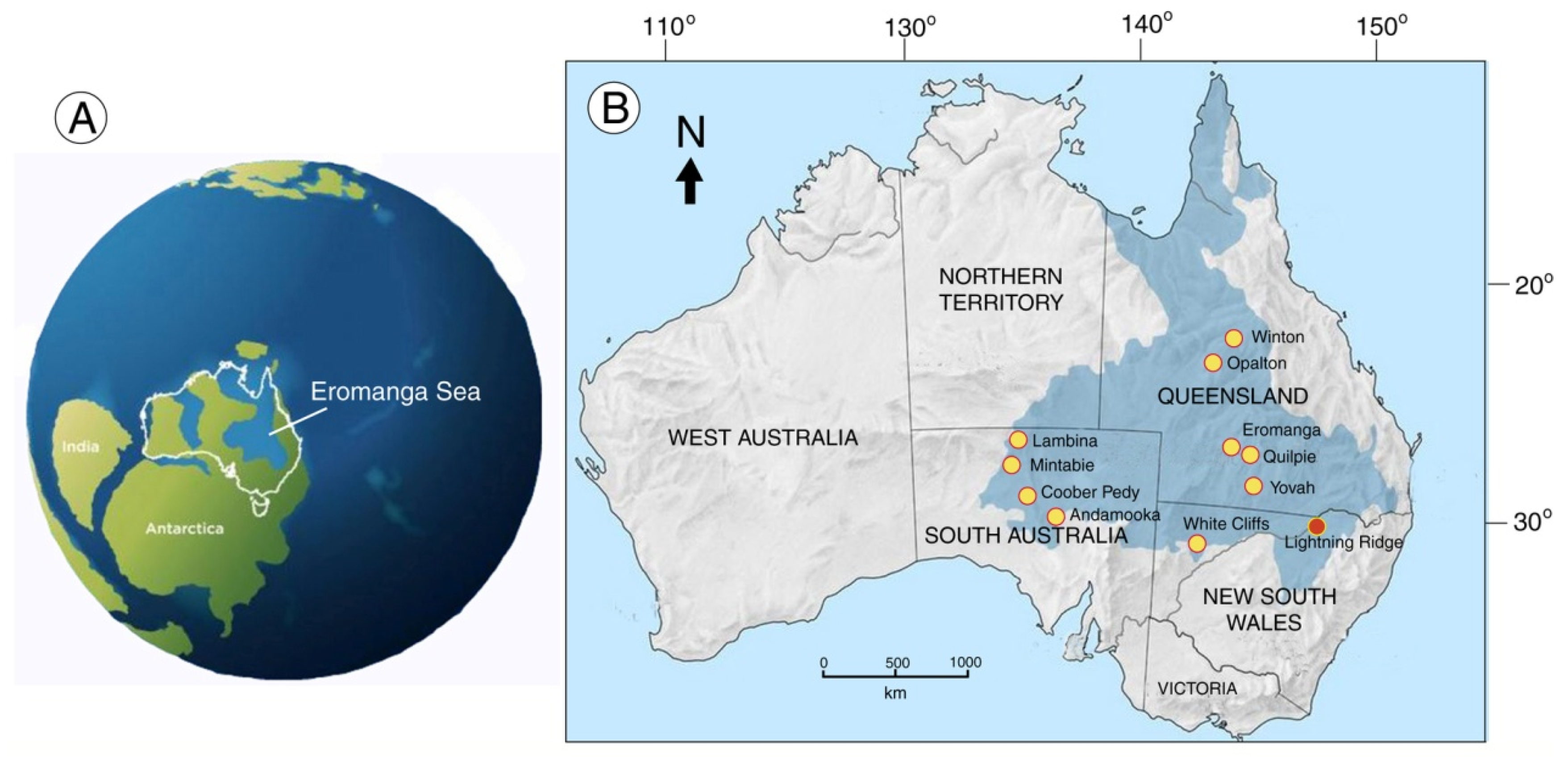

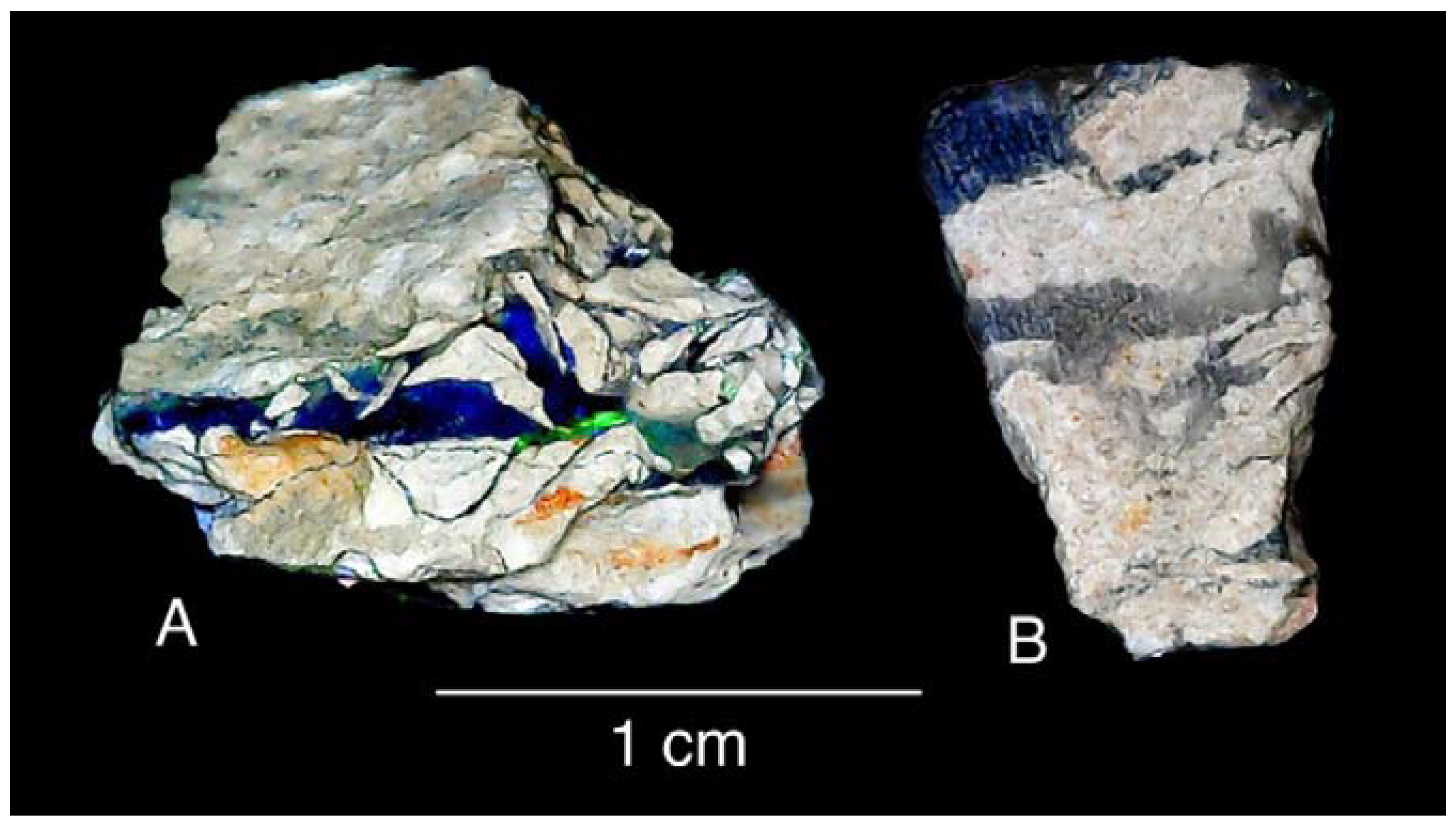
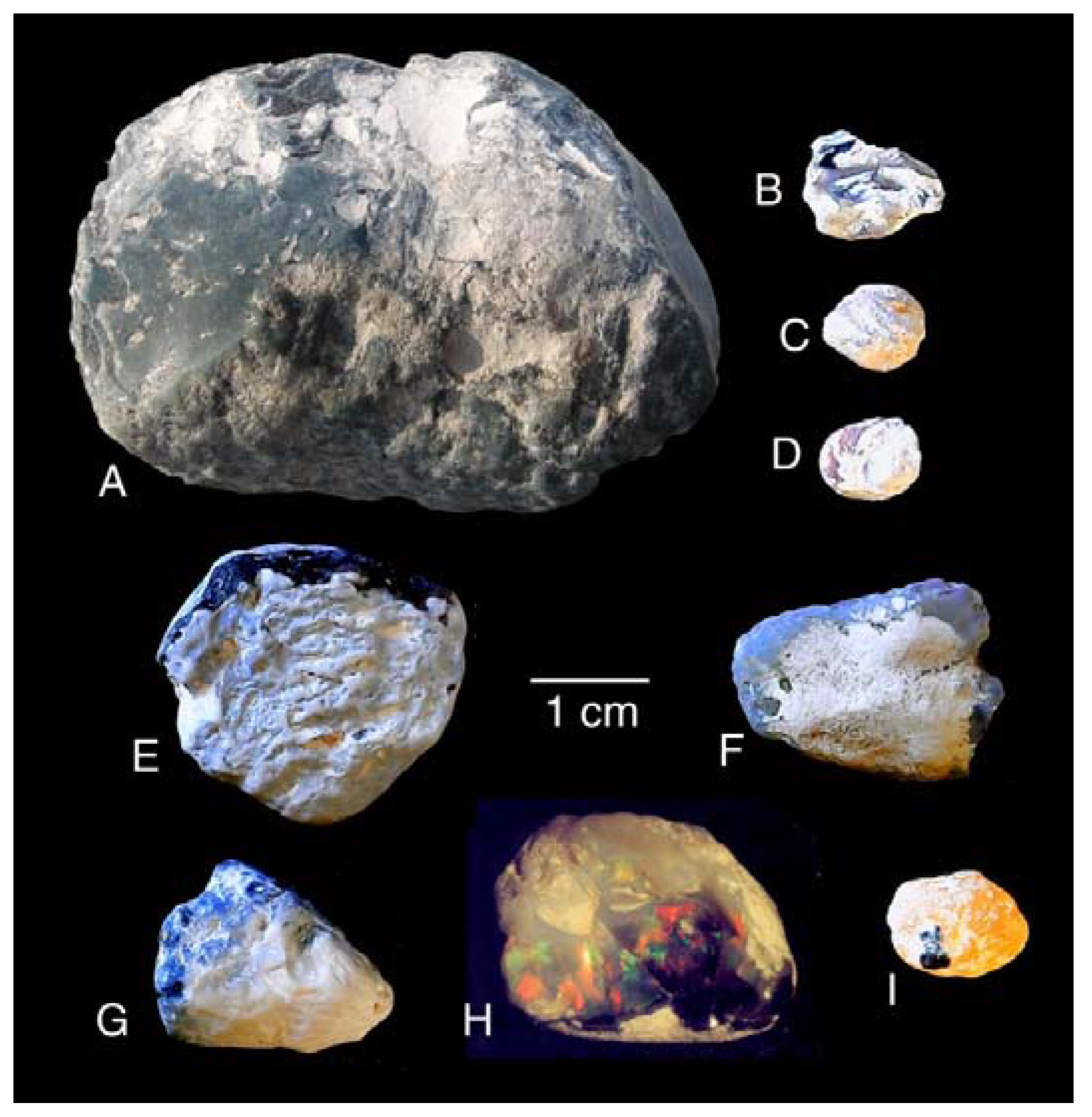
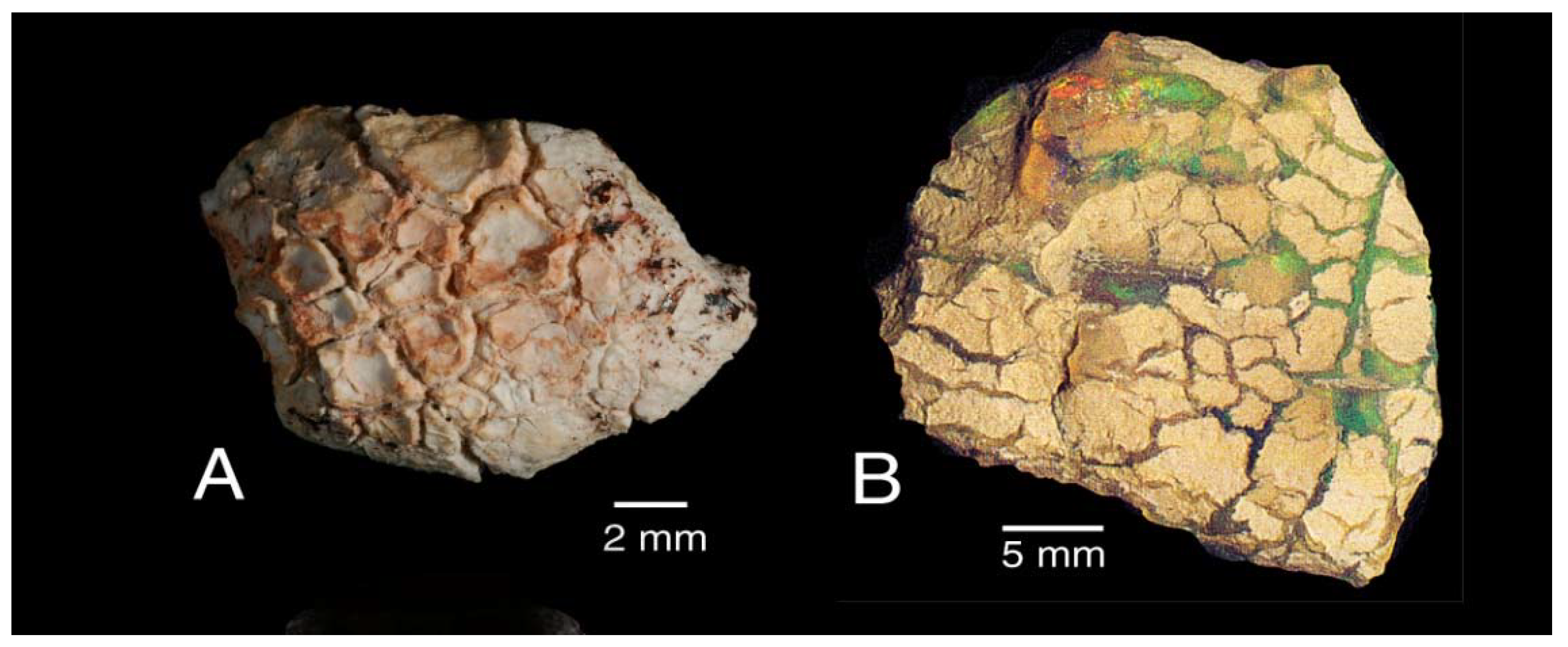
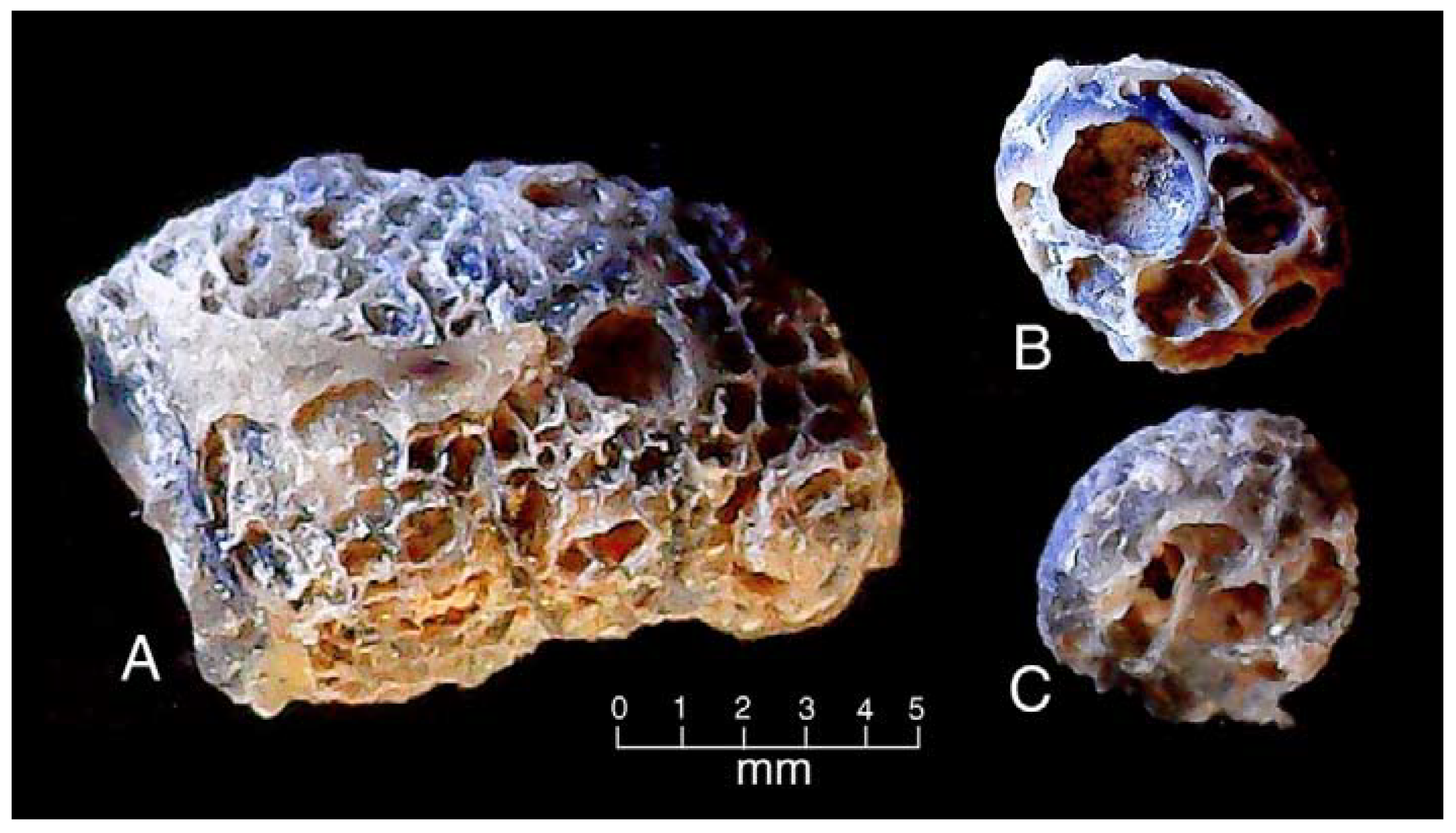
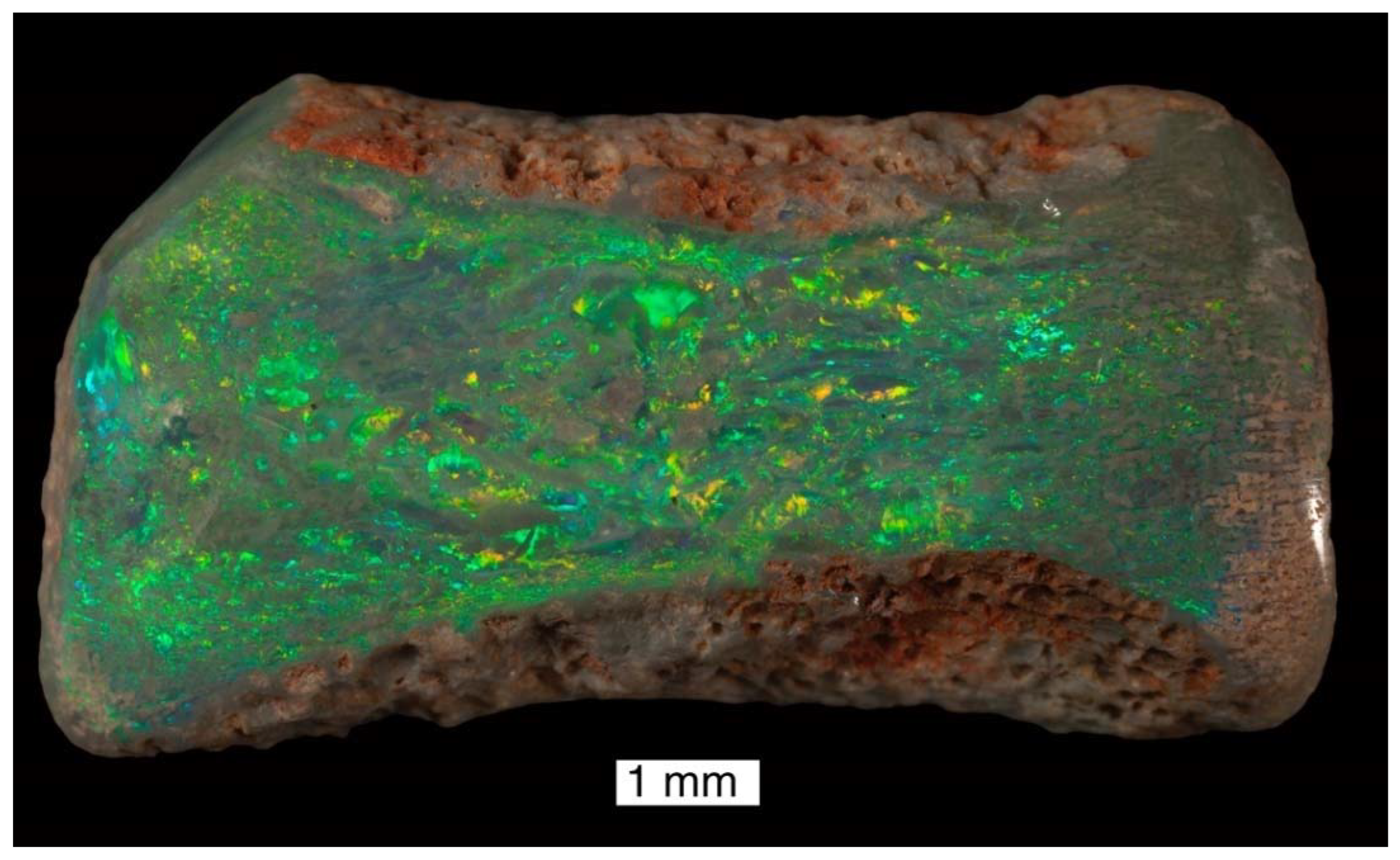
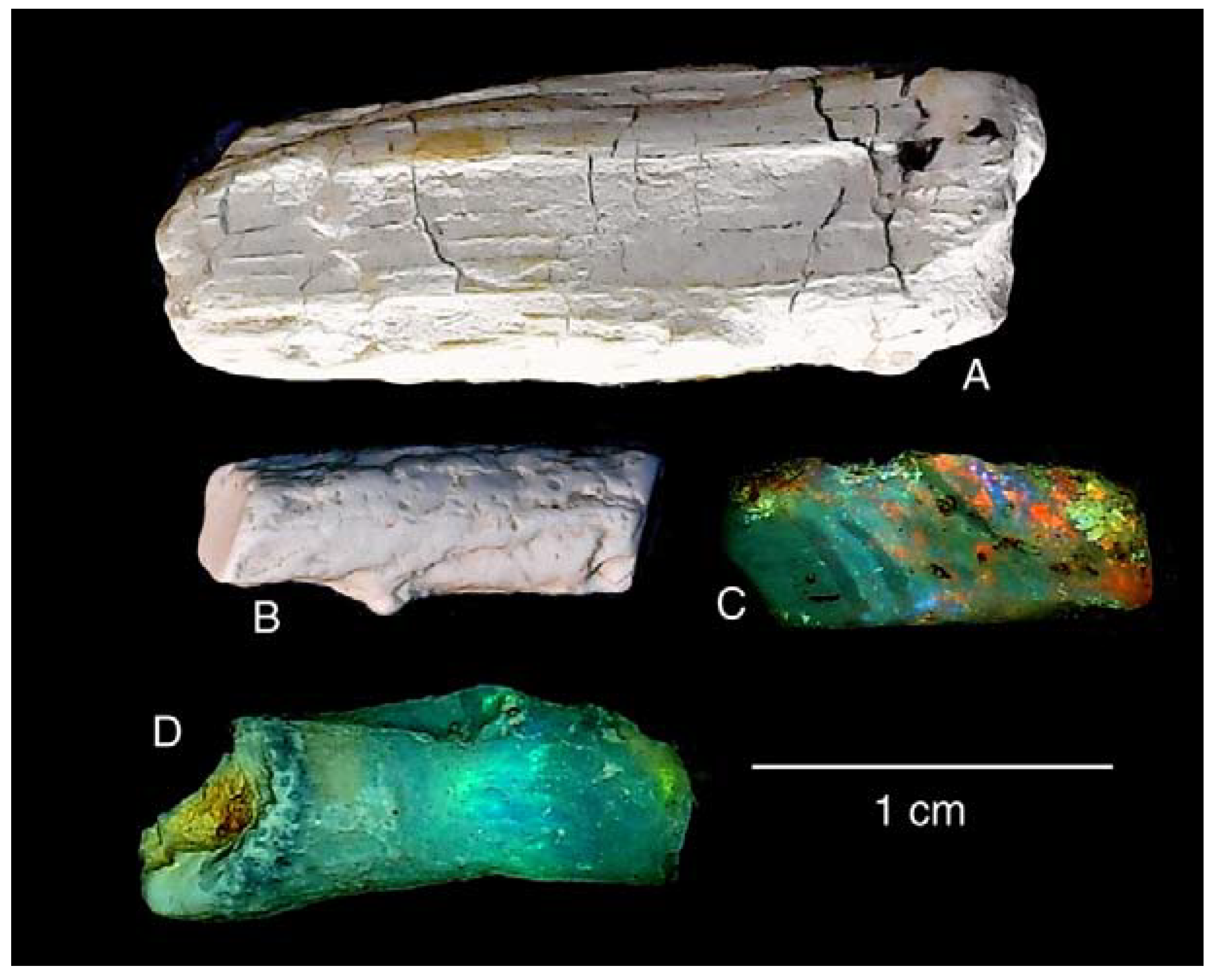
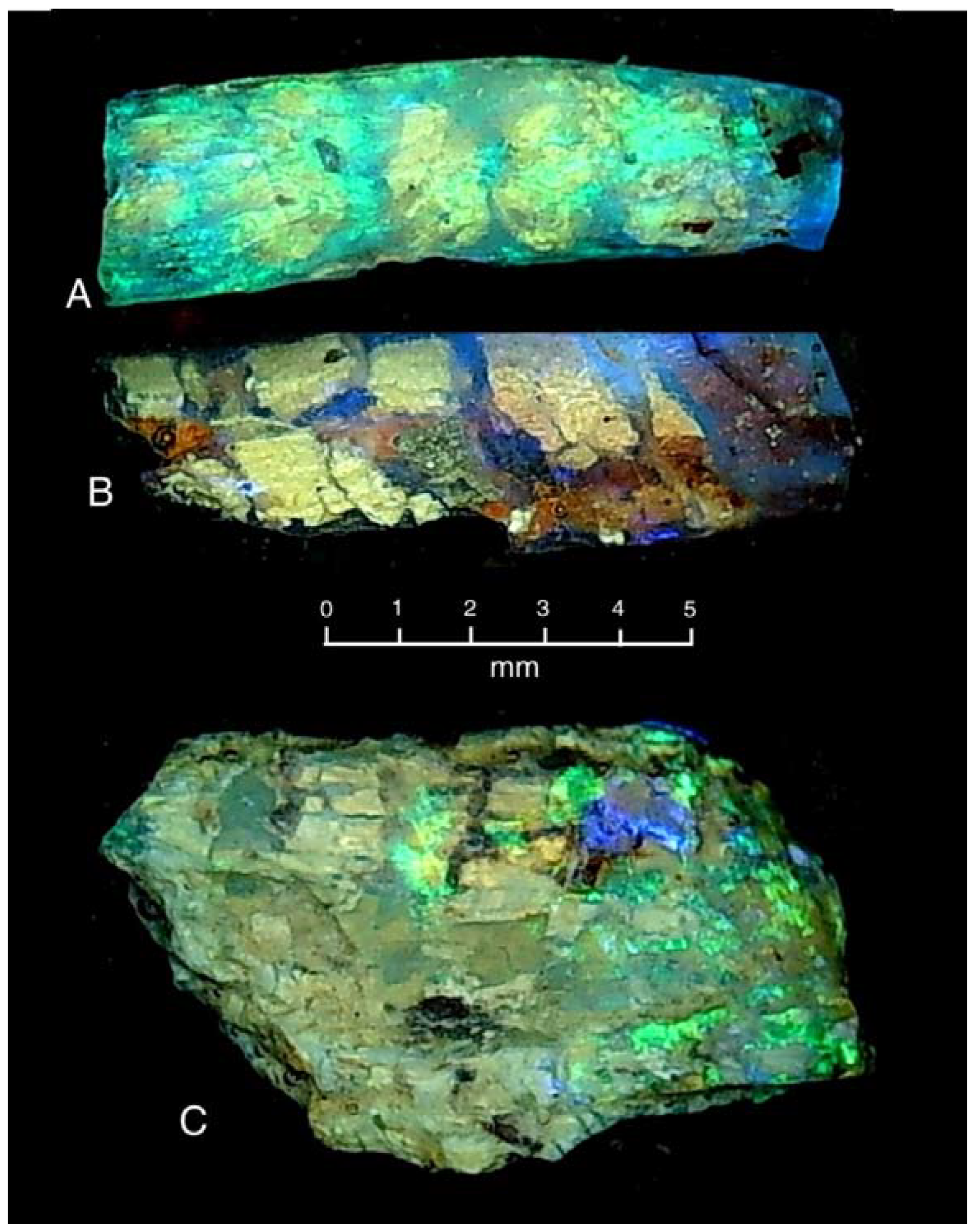
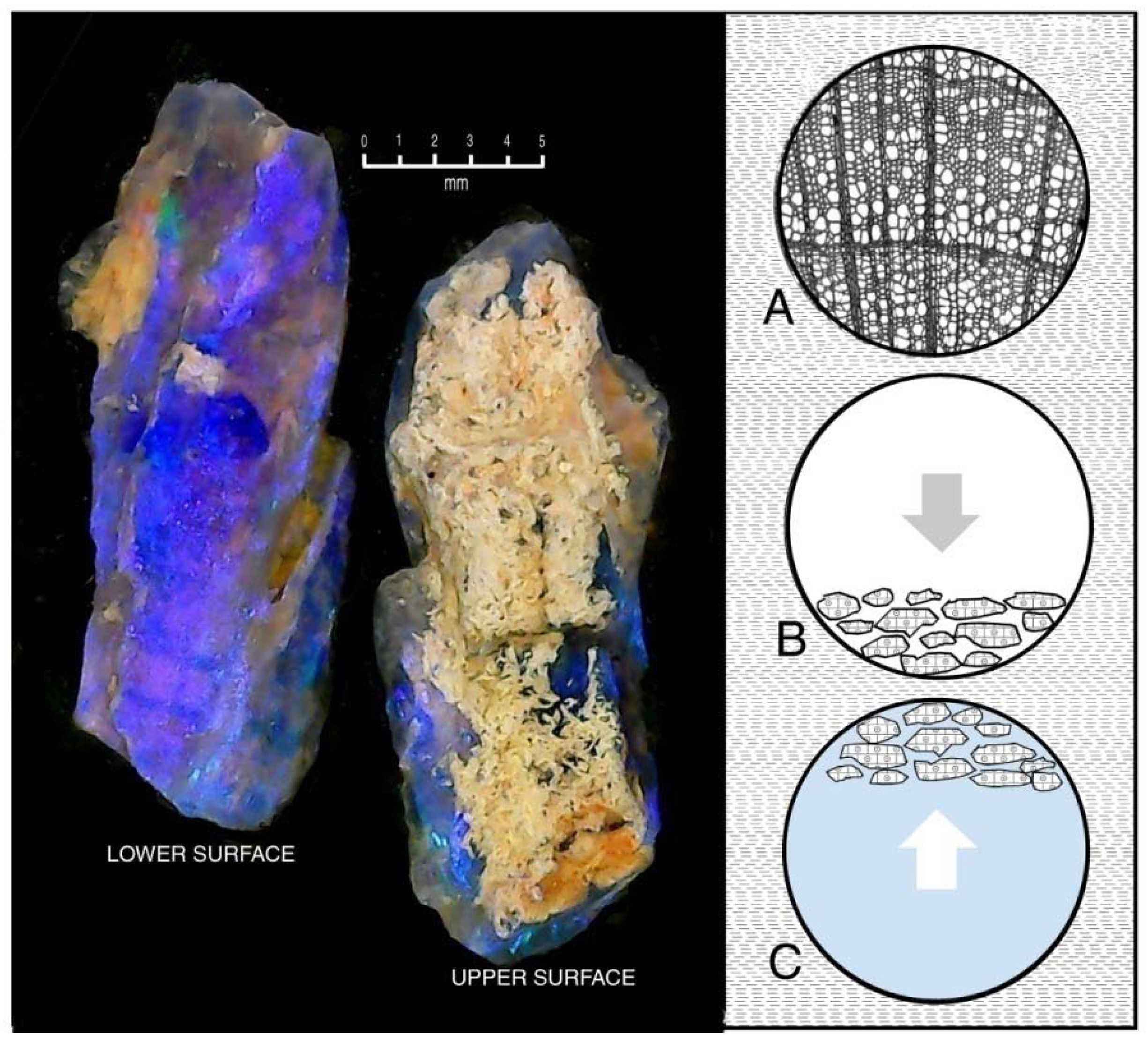
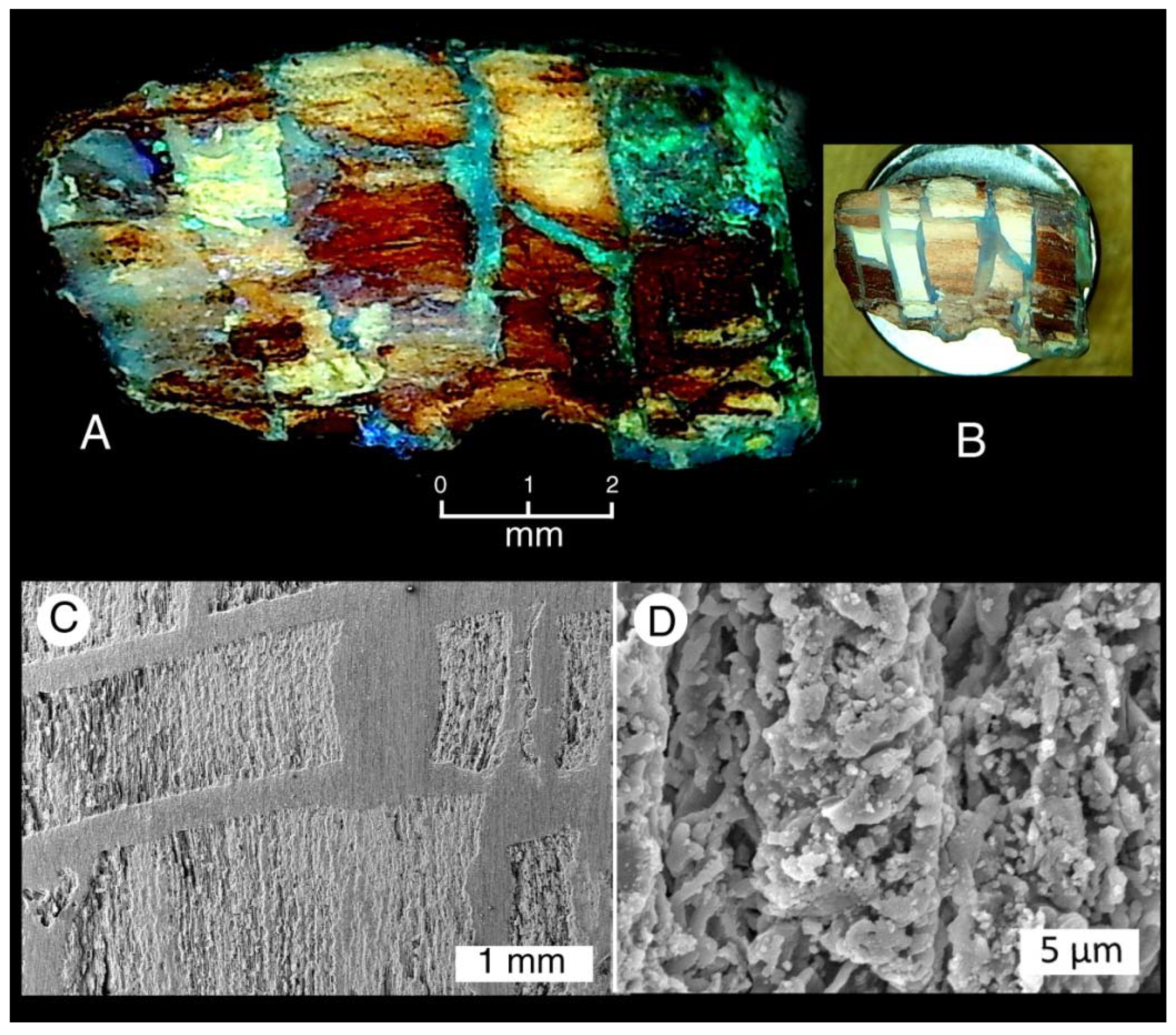
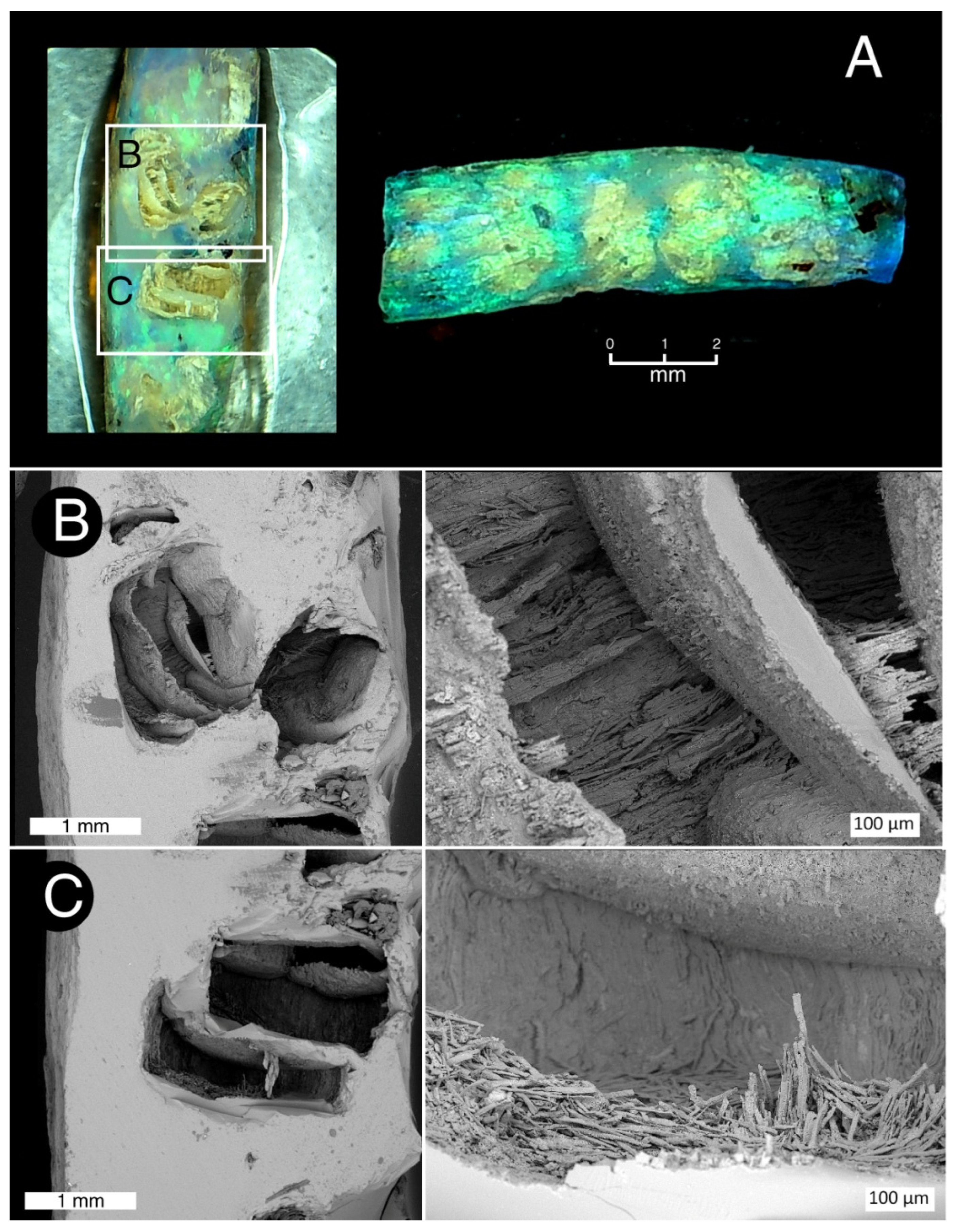
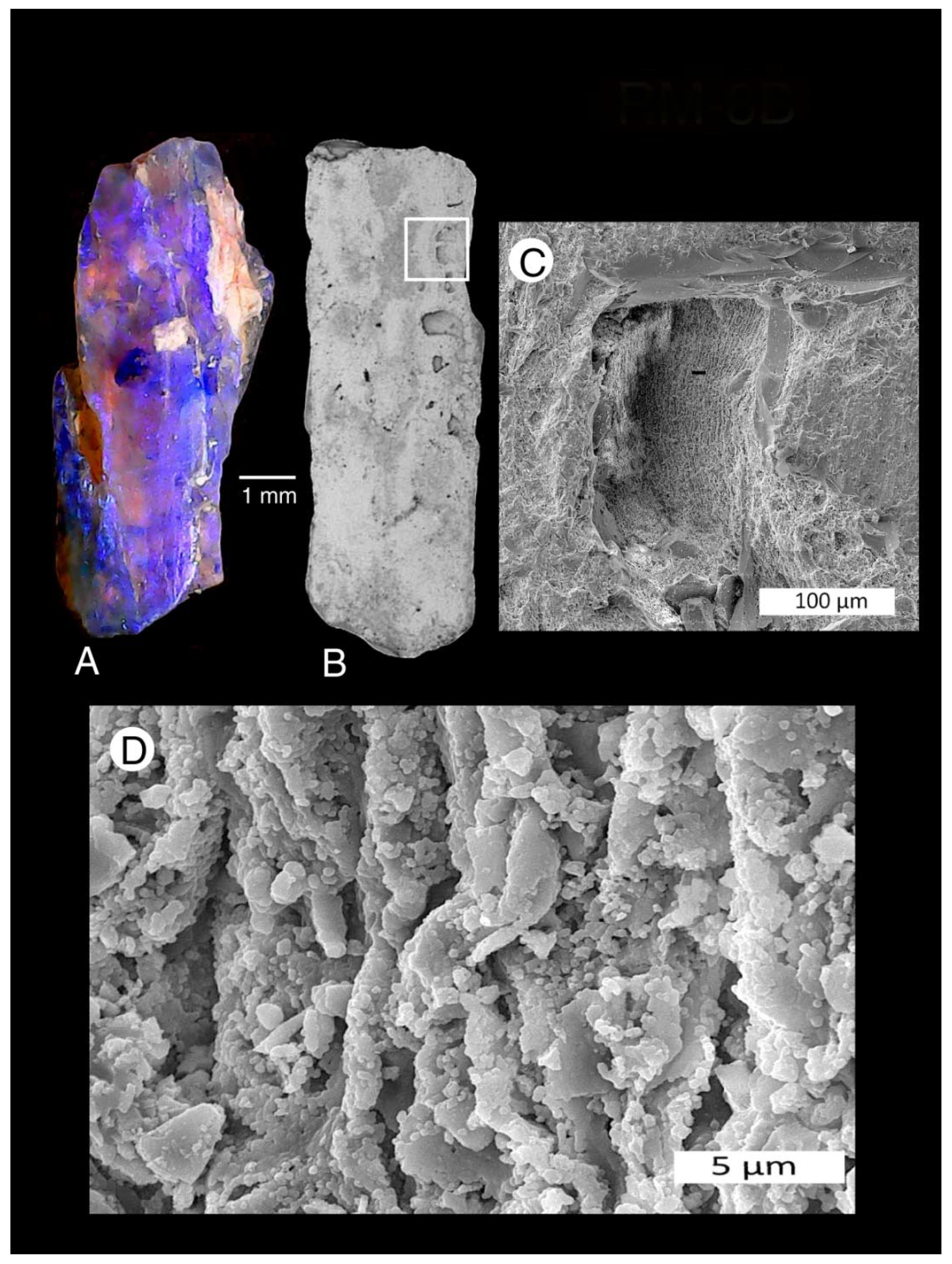
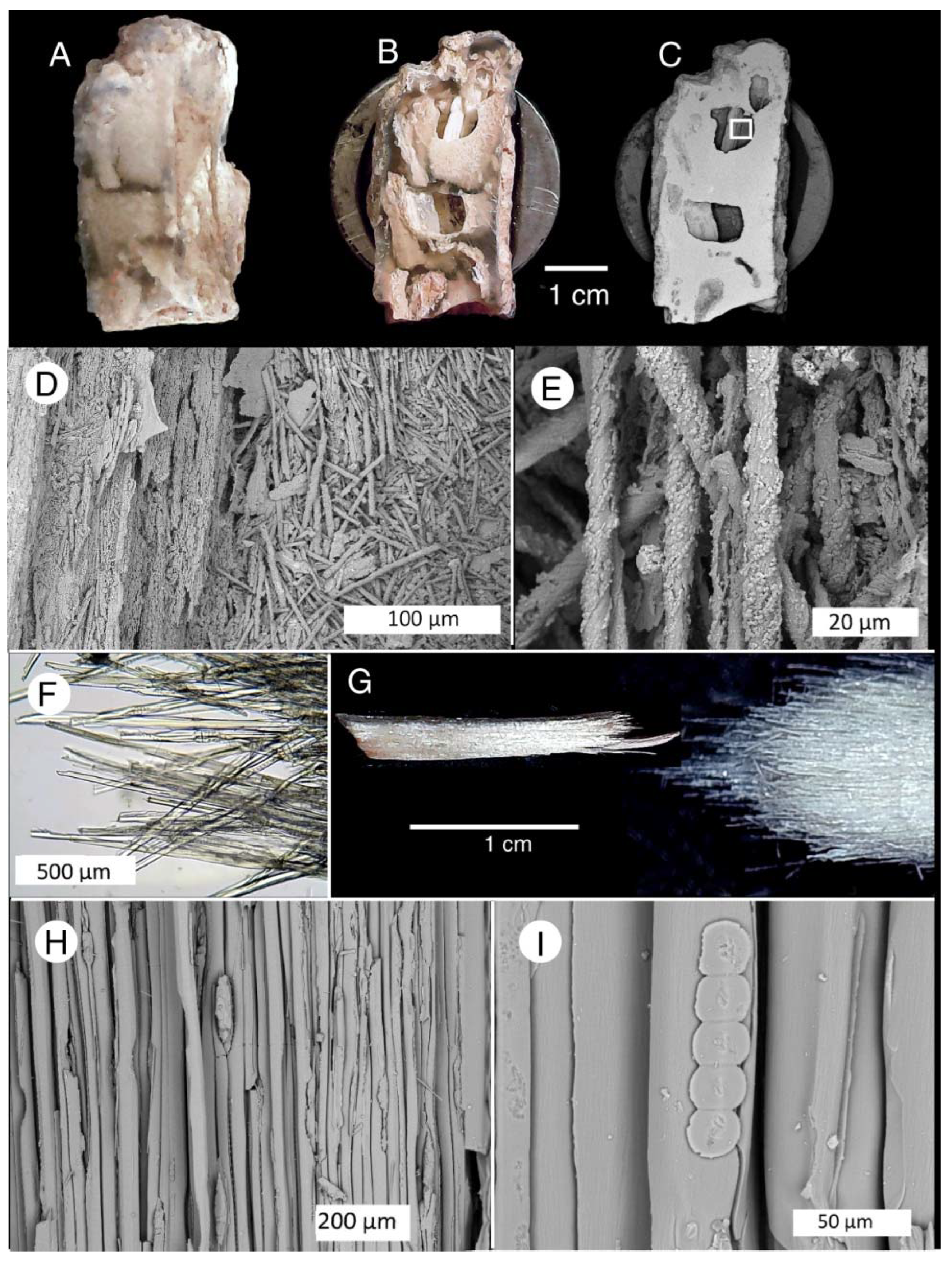

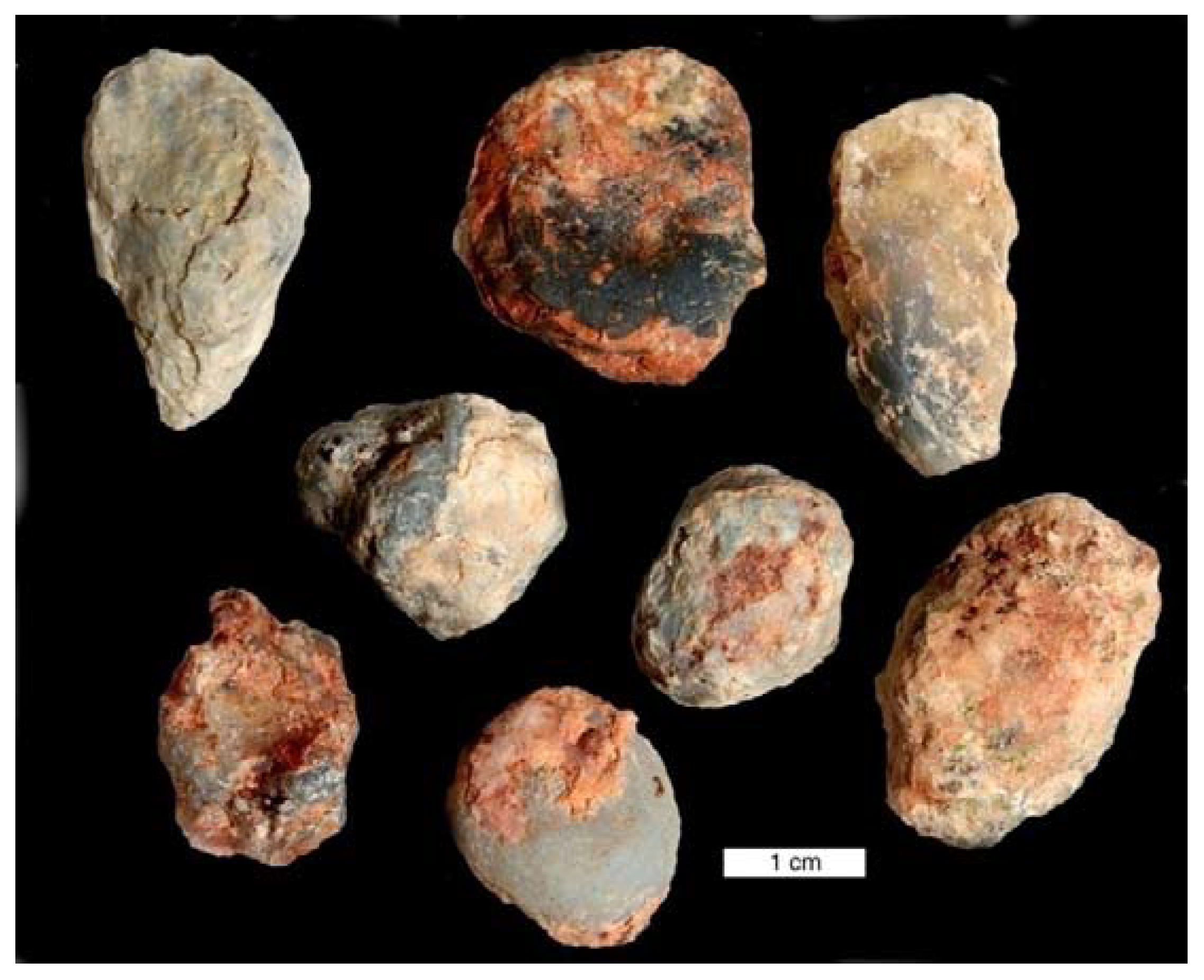

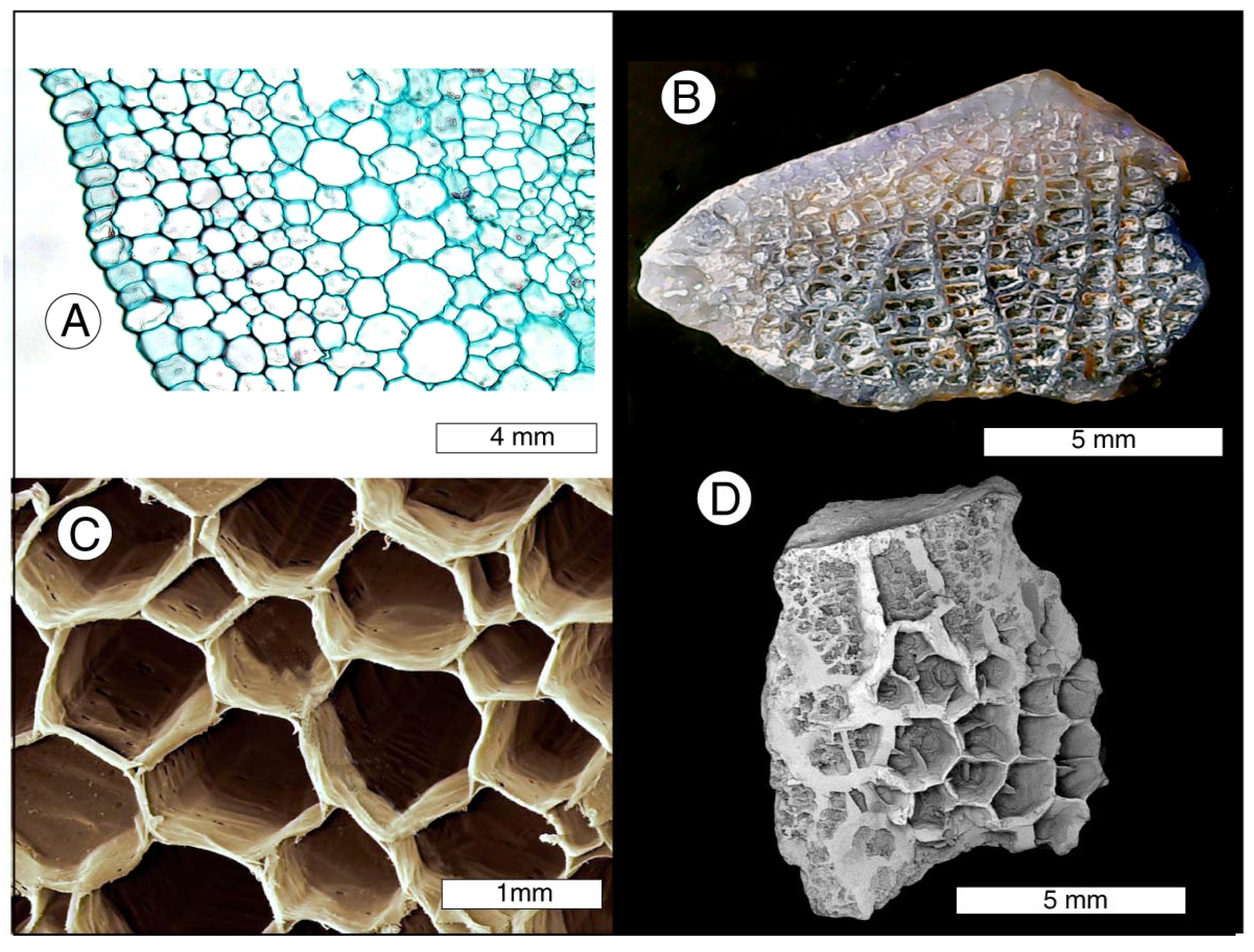
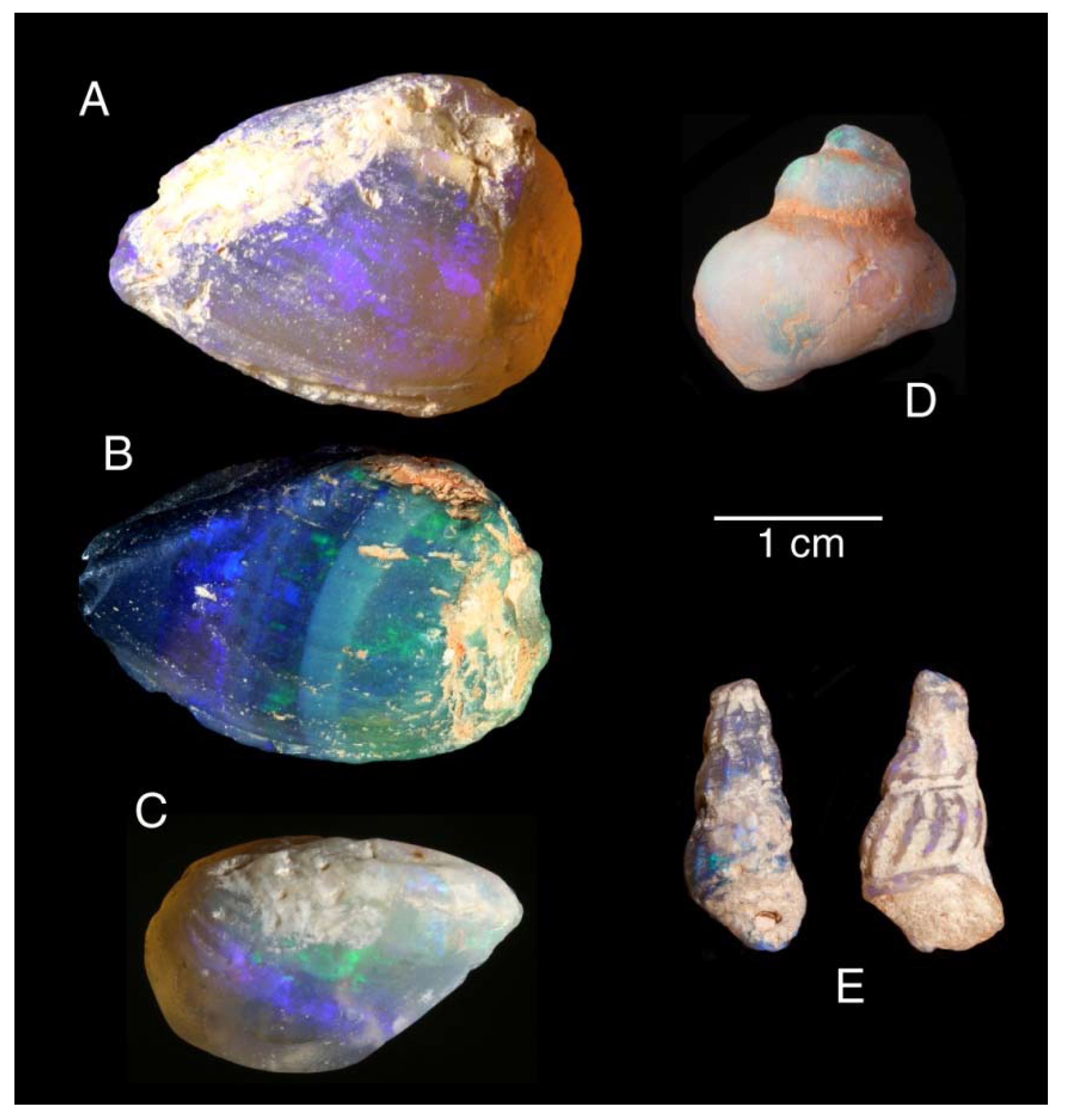

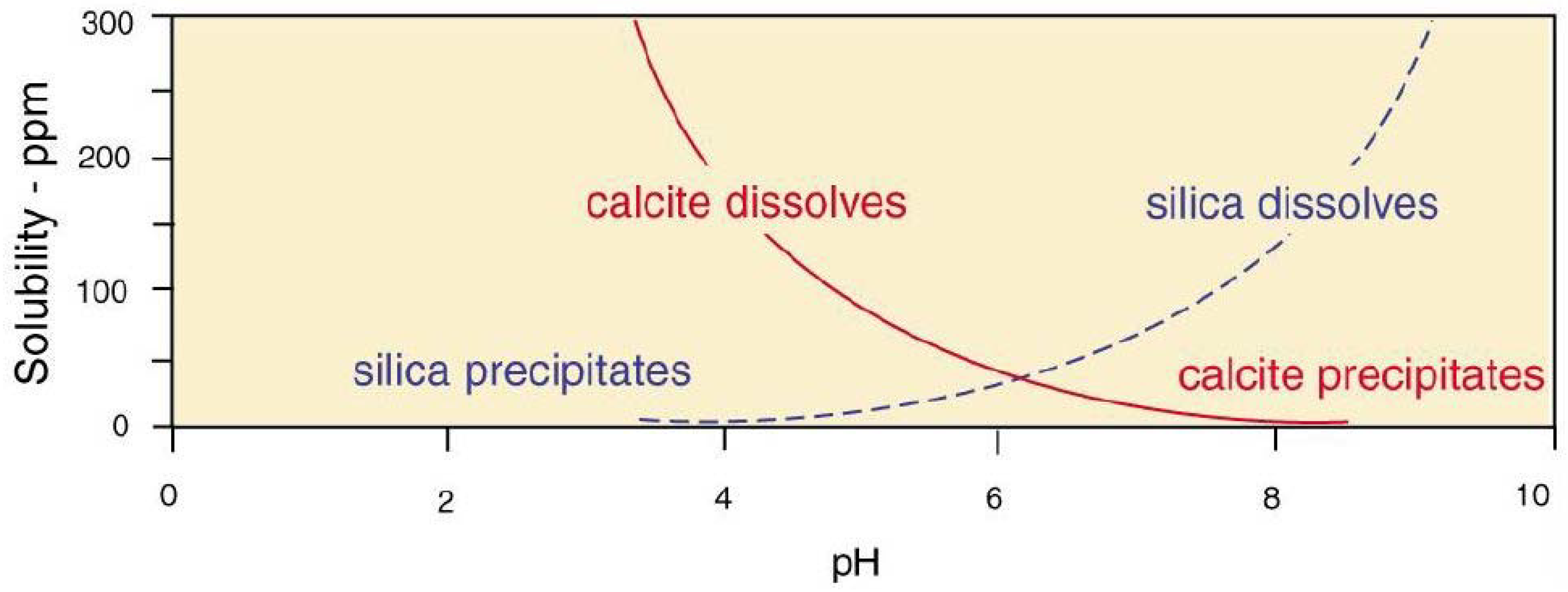


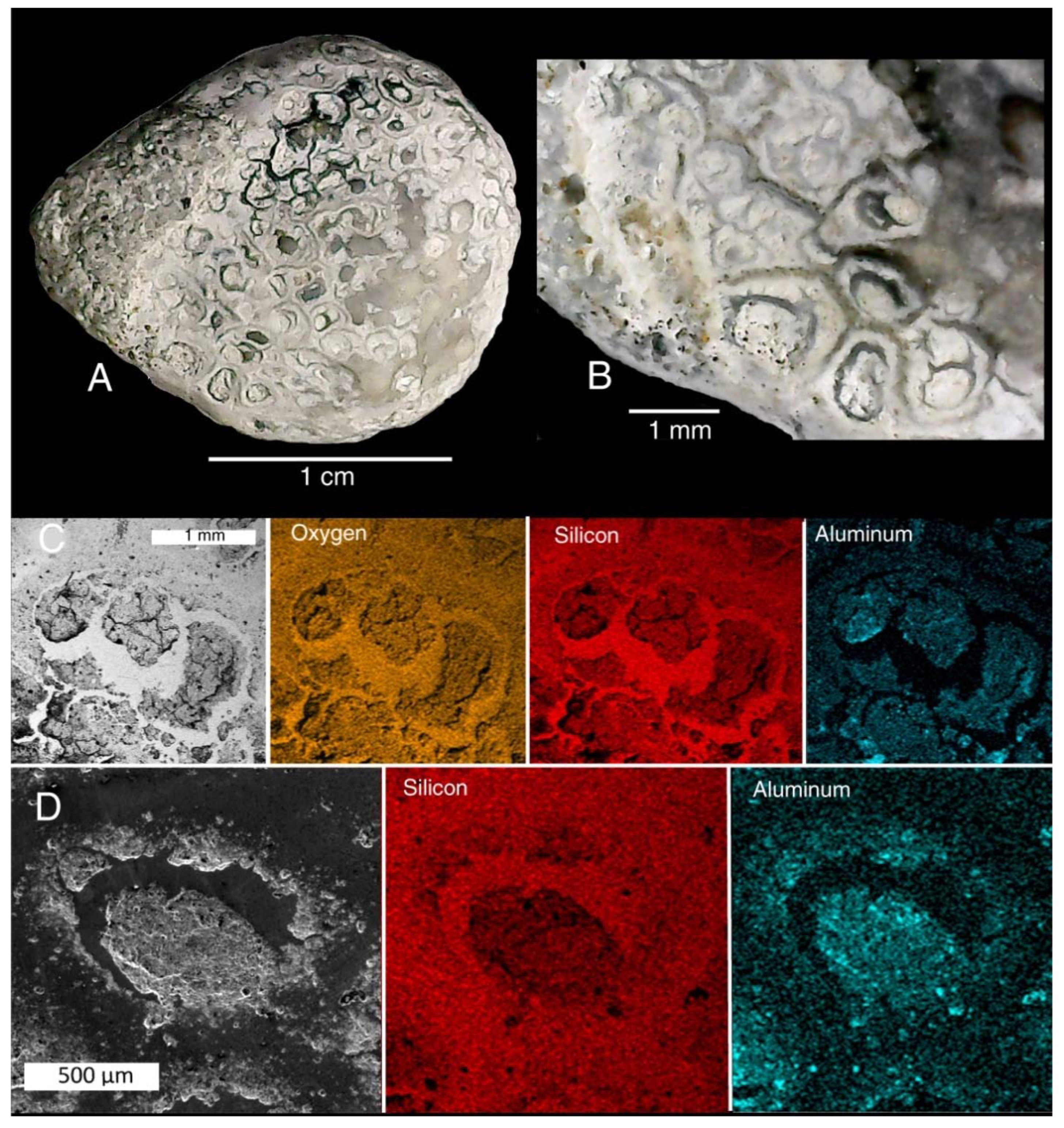


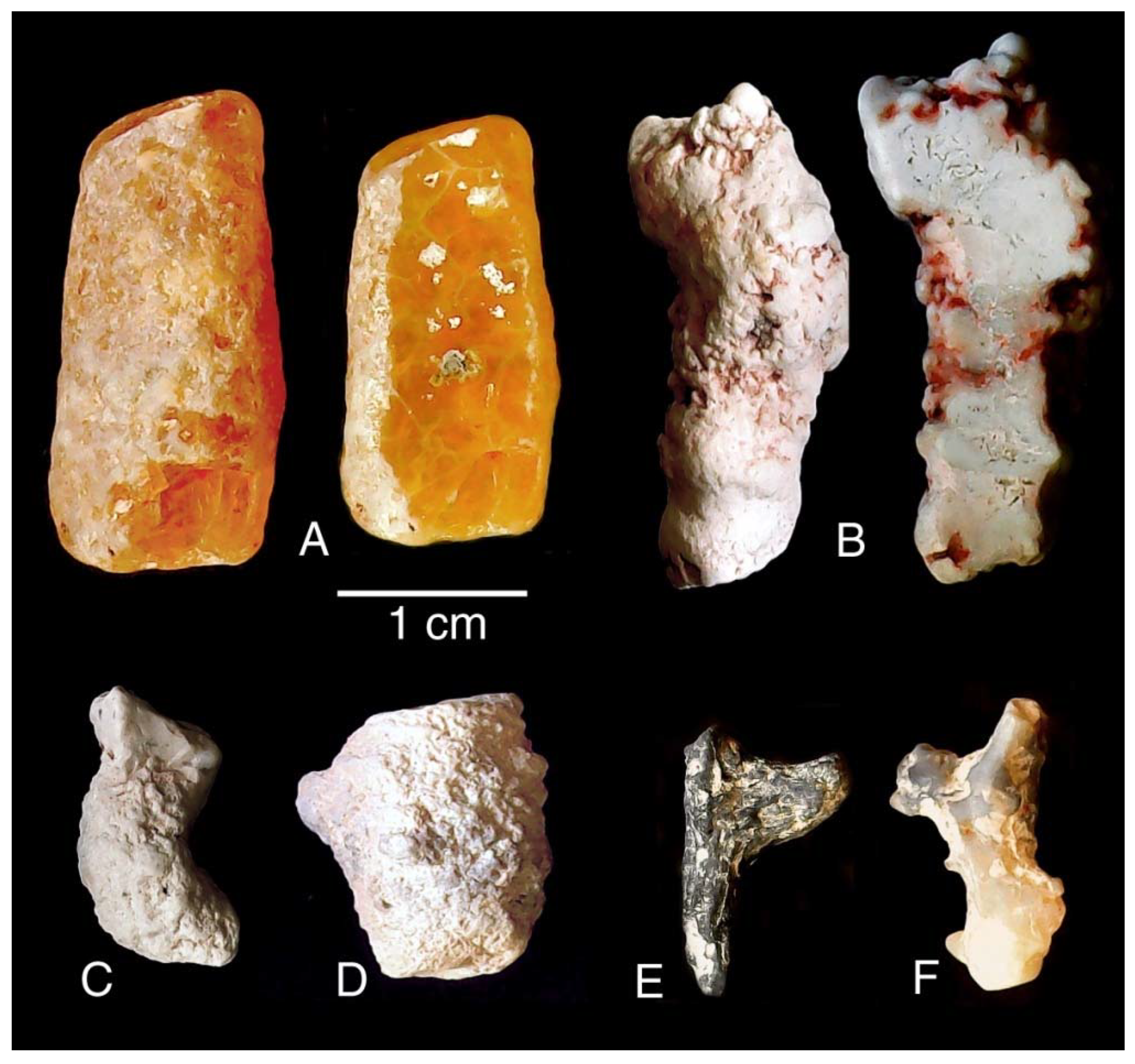
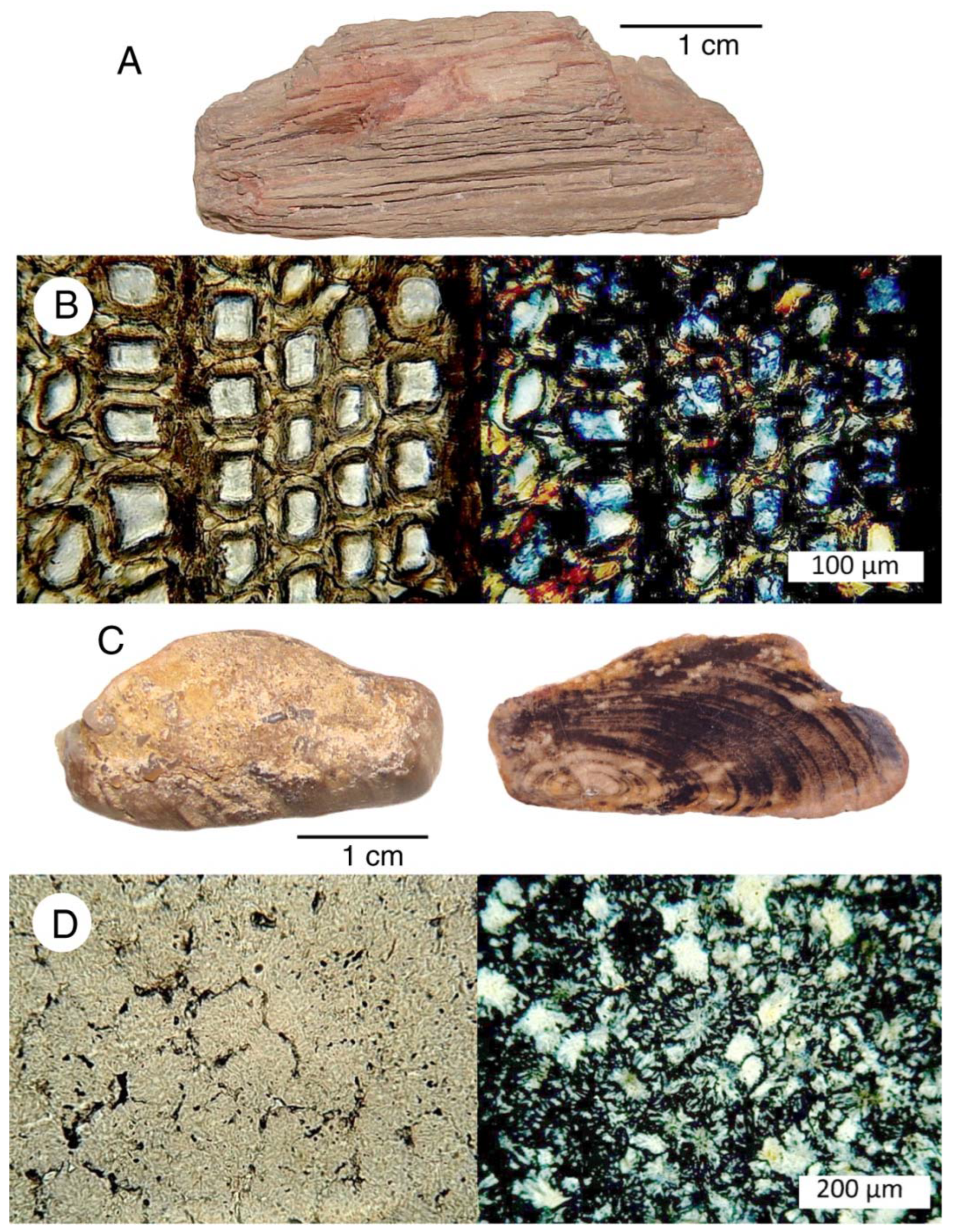


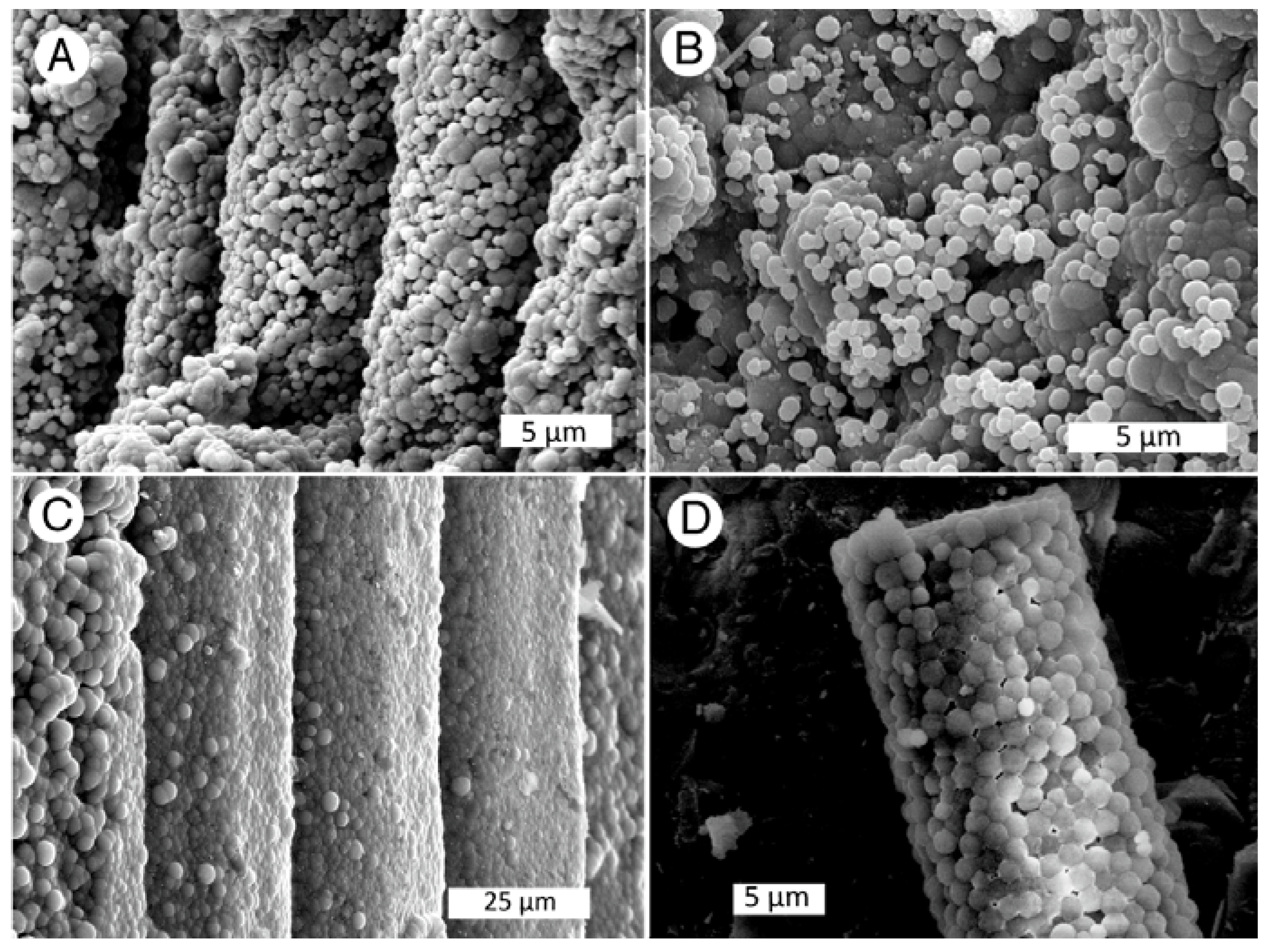

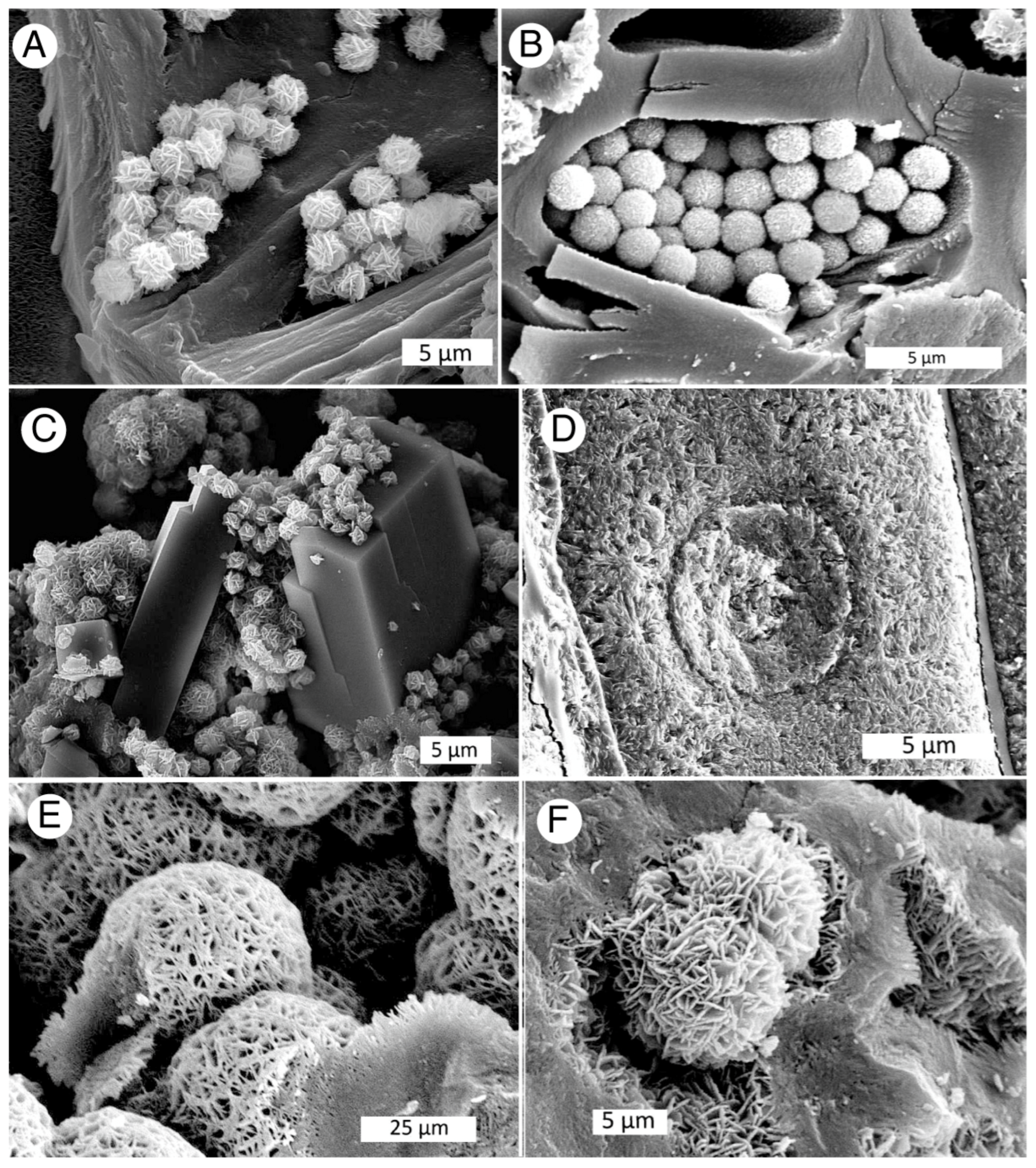
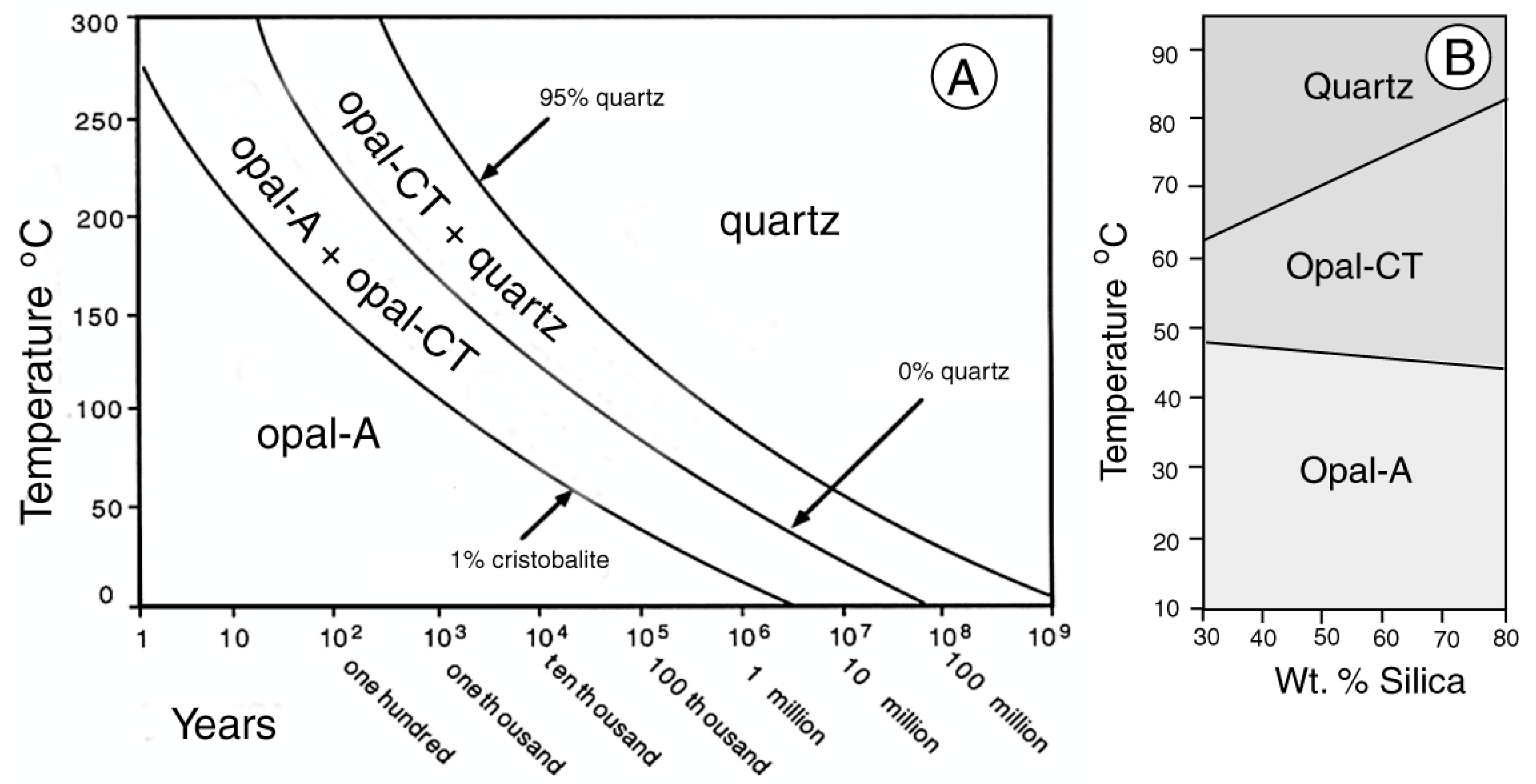
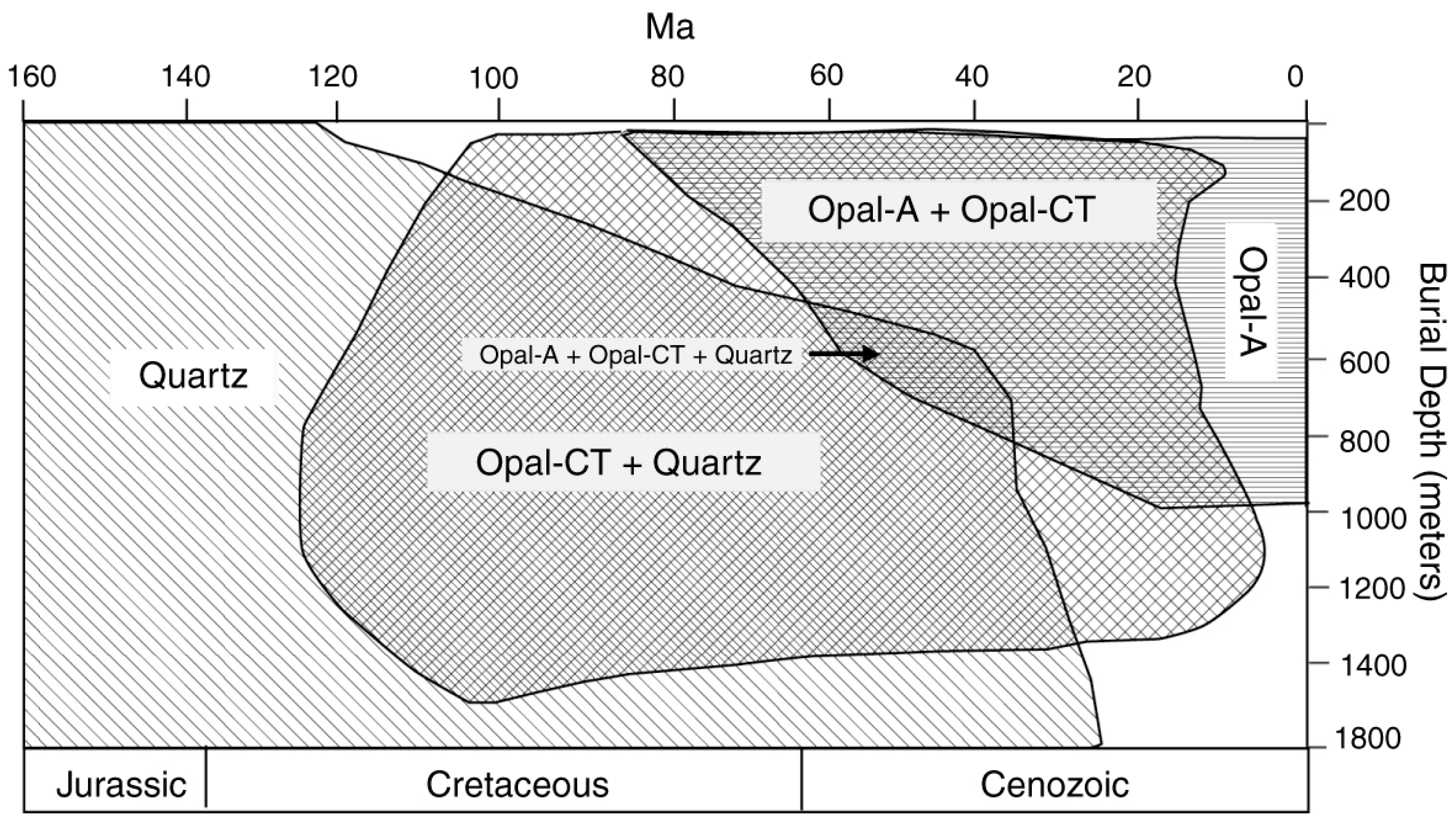
Disclaimer/Publisher’s Note: The statements, opinions and data contained in all publications are solely those of the individual author(s) and contributor(s) and not of MDPI and/or the editor(s). MDPI and/or the editor(s) disclaim responsibility for any injury to people or property resulting from any ideas, methods, instructions or products referred to in the content. |
© 2023 by the authors. Licensee MDPI, Basel, Switzerland. This article is an open access article distributed under the terms and conditions of the Creative Commons Attribution (CC BY) license (https://creativecommons.org/licenses/by/4.0/).
Share and Cite
Mustoe, G.E.; Smith, E.T. Timing of Opalization at Lightning Ridge, Australia: New Evidence from Opalized Fossils. Minerals 2023, 13, 1471. https://doi.org/10.3390/min13121471
Mustoe GE, Smith ET. Timing of Opalization at Lightning Ridge, Australia: New Evidence from Opalized Fossils. Minerals. 2023; 13(12):1471. https://doi.org/10.3390/min13121471
Chicago/Turabian StyleMustoe, George E., and Elizabeth T. Smith. 2023. "Timing of Opalization at Lightning Ridge, Australia: New Evidence from Opalized Fossils" Minerals 13, no. 12: 1471. https://doi.org/10.3390/min13121471
APA StyleMustoe, G. E., & Smith, E. T. (2023). Timing of Opalization at Lightning Ridge, Australia: New Evidence from Opalized Fossils. Minerals, 13(12), 1471. https://doi.org/10.3390/min13121471






